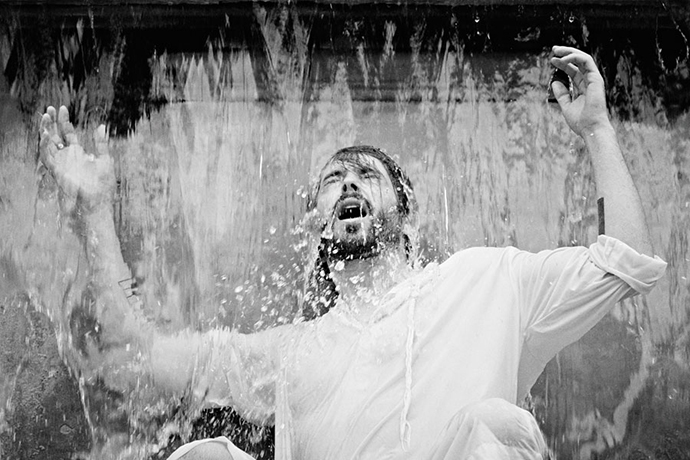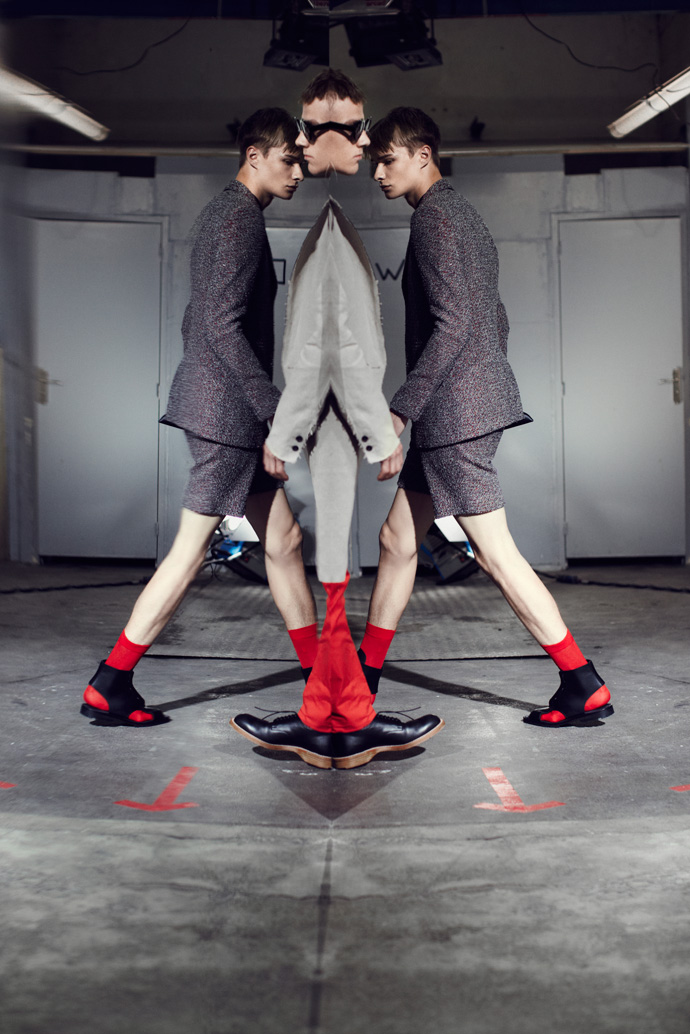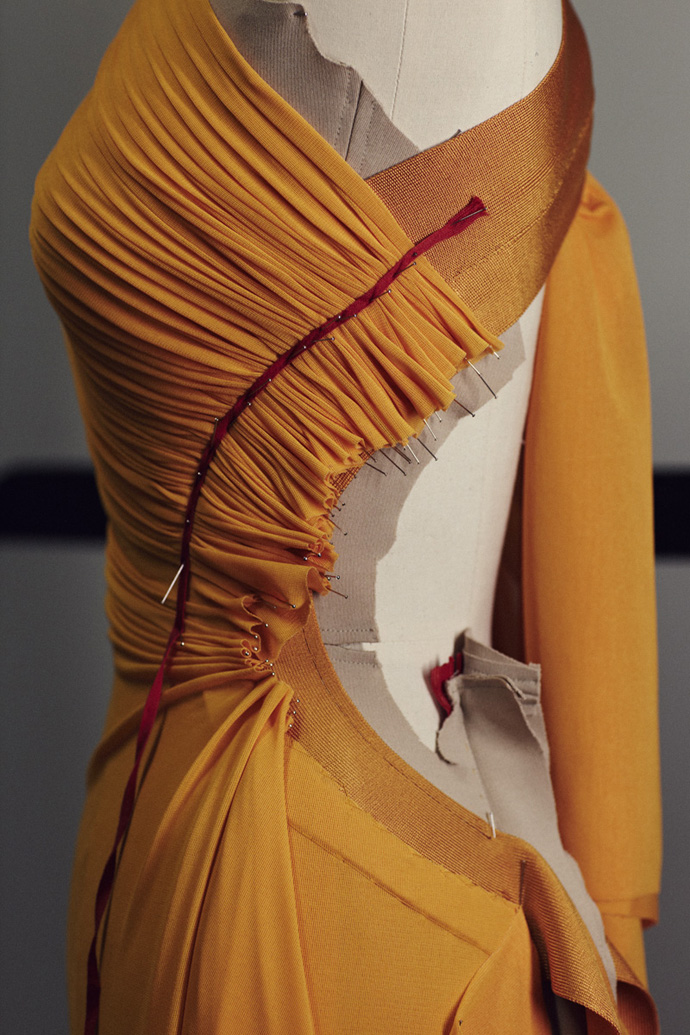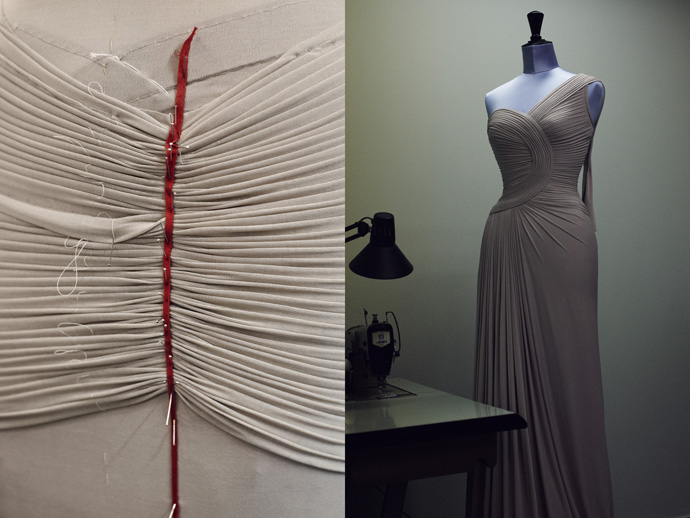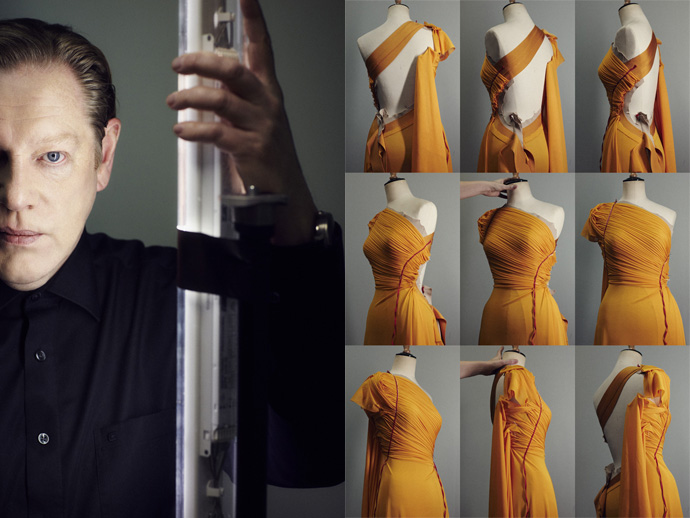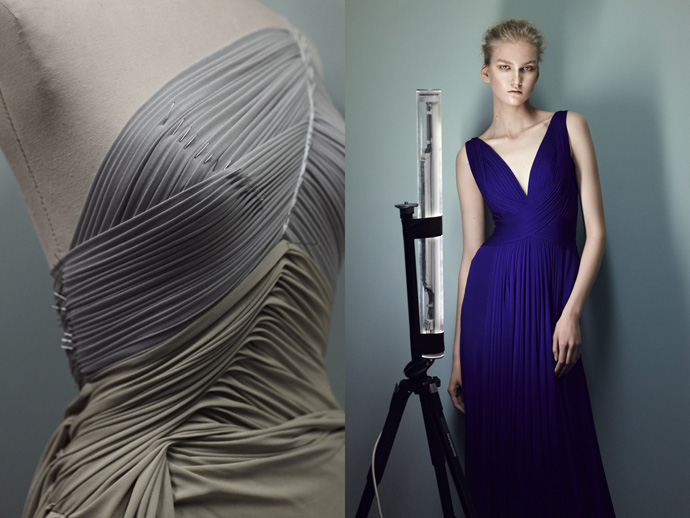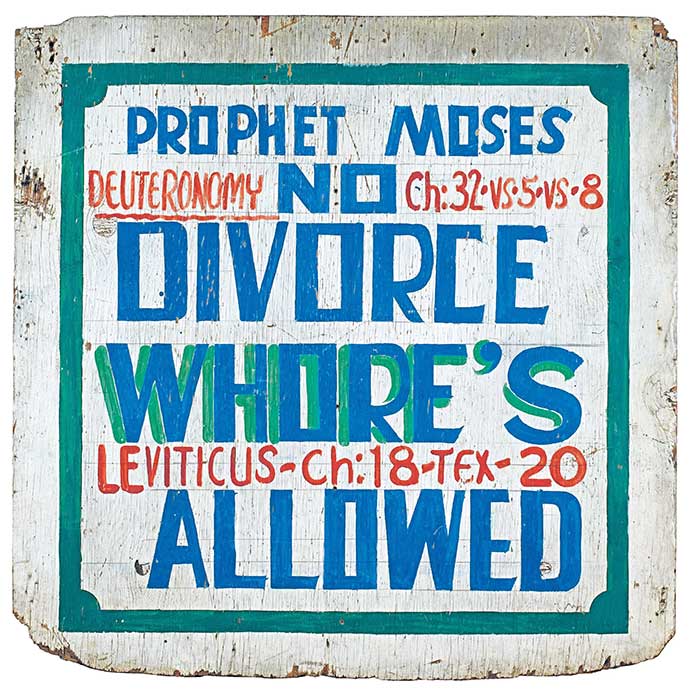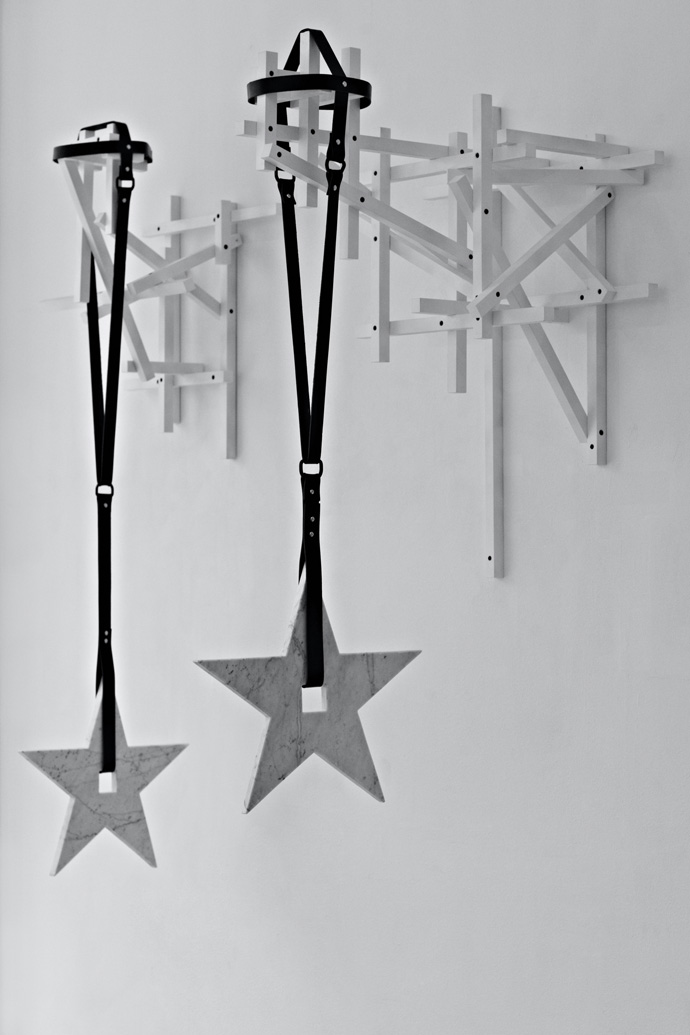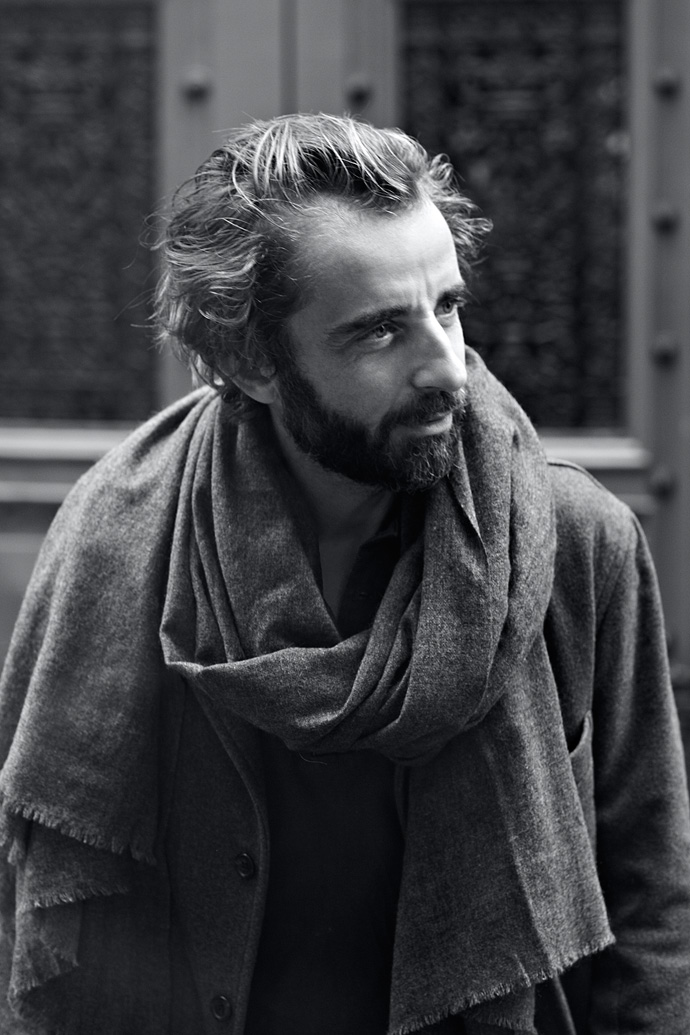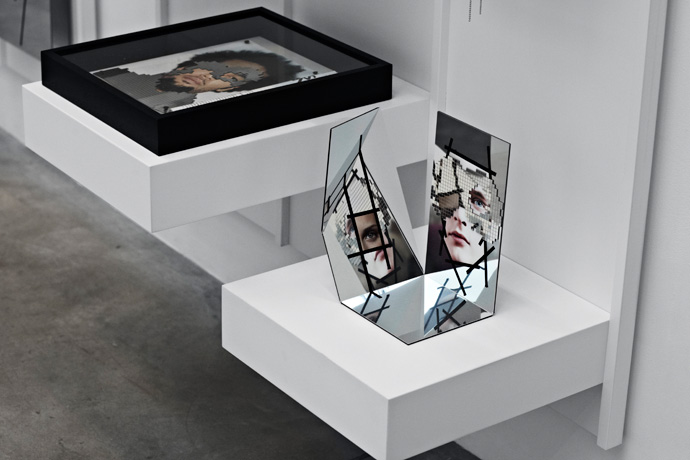-

paris is dead – bap-tepr-ism
-Welcome to your Paris baptism.
Photography by René Habermacher.
Styling by Suzanne von Aichinger, with Maison Martin Margiela.
Concept by Antoine Asseraf.Transcribed by Amandine Flament. Translated by Edward Siddons.
Assisted by Amandine Flament & Ed Siddons.read more on PARIS IS DEAD.COM
00 -

Kostas Murkudis
-Putting Kostas Murkudis, with his East German utilitarian approach, at the helm of Closed jeans, a brand defined by the relationship between function and form, is a match in heaven, in a time where the initial idea of fashion is caught between mass production and the arbitrary grip of luxury-obsessed conglomerates.
They each bring their own interesting history and their associations to big names to a collaboration very much anchored in the “now” – on one side, Marithé and François Girbaud, who founded Closed in the 70’s, and on the other, Helmut Lang, with whom Murkudis worked during the label’s early and formative years, though both brand and designer exist in their own right.
For women’s fashion week in September, Closed will open its first flagship store in Paris.
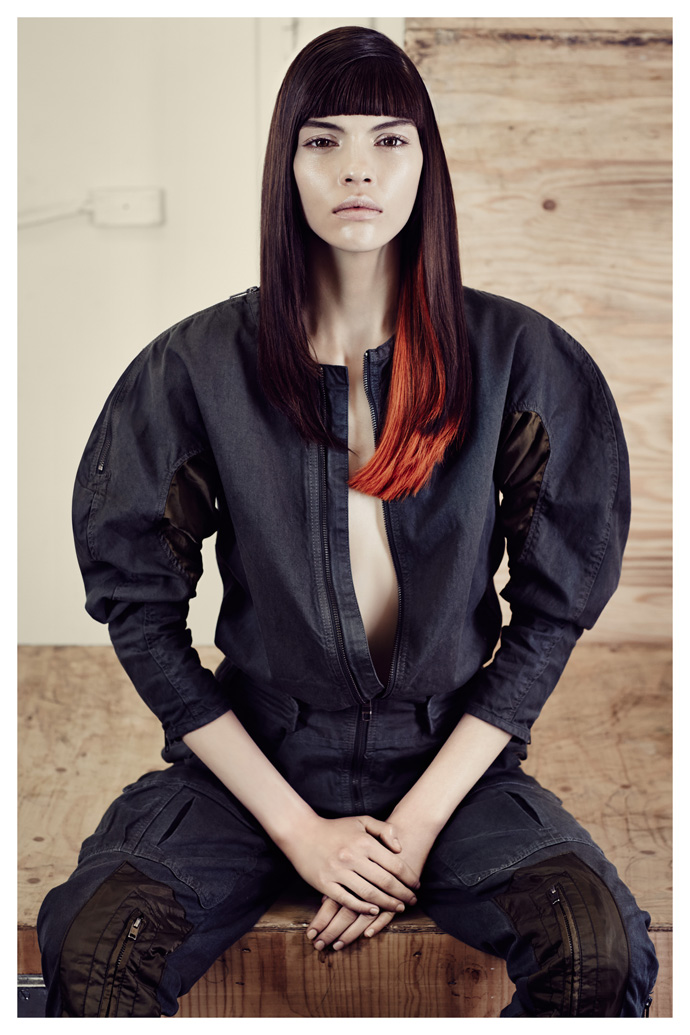
Overall "Illusion" from the FW 13/14 collection by Kostas Murkudis for Closed Jeans. Photography by René Habermacher
René Habermacher: When I heard you’d be working for Closed jeans, I thought it made great sense with your approach – sustainability, resistance, utilitarianism and uniformity are expressions that come to mind when thinking of your work, and all of these seem to be relevant in the context of jeanswear.
KM: I grew up in the DDR (German Democratic Republic), in East Germany, so these are surely aspects of my work that I value and are part of my professional ethos that I will follow up into the future. It’s my contribution, to make it accessible to more people than for example with my own brand.
I always had “two hearts beating in my chest”: one more poetic, free of necessities, and the other that is more about durability and functionality everyday. I always loved the approach of the Bauhaus, it is very important to me. But I really do love both aspects. Now with my new mission at Closed, I can really apply everything you described, I have all tools and a fantastic team I love working with.
For me this is the perfect balance between the two brands.Whereas with my own brand, my mini-label that I call my laboratory, I don’t have to think about whether the piece is really durable, has the right pocket or whatever. I just can do projects important to me, which do not necessarily have anything to do with fashion. For example recently I have worked with a royal glass manufactory in Munich, Lobmeyr, that usually do stuff like church windows etc. I think there are so many possibilities and I am very curious for new challenges.
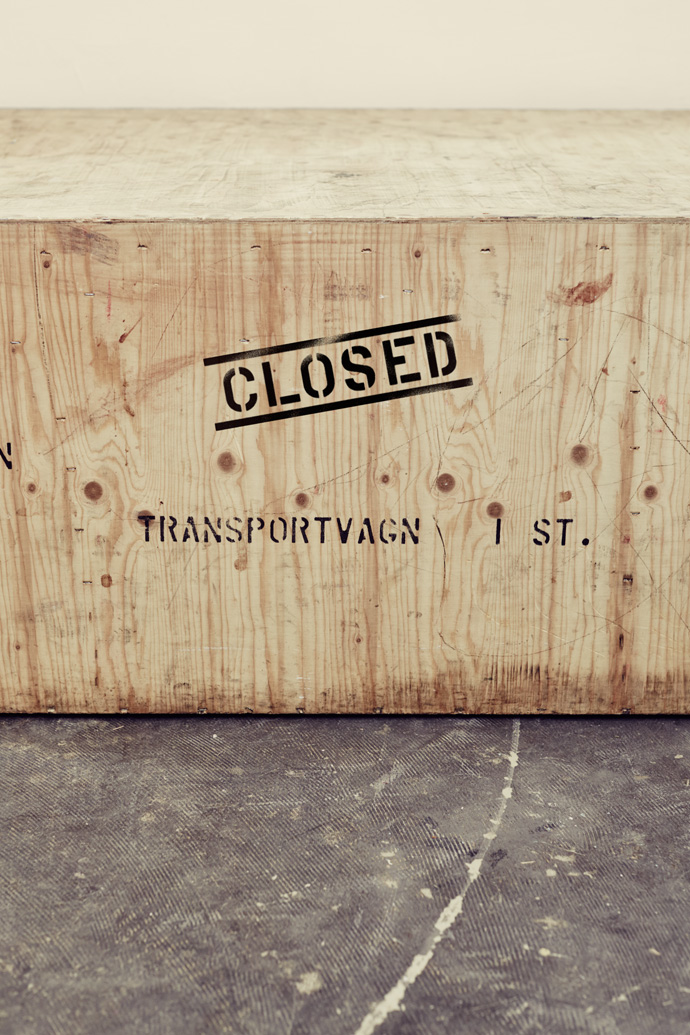
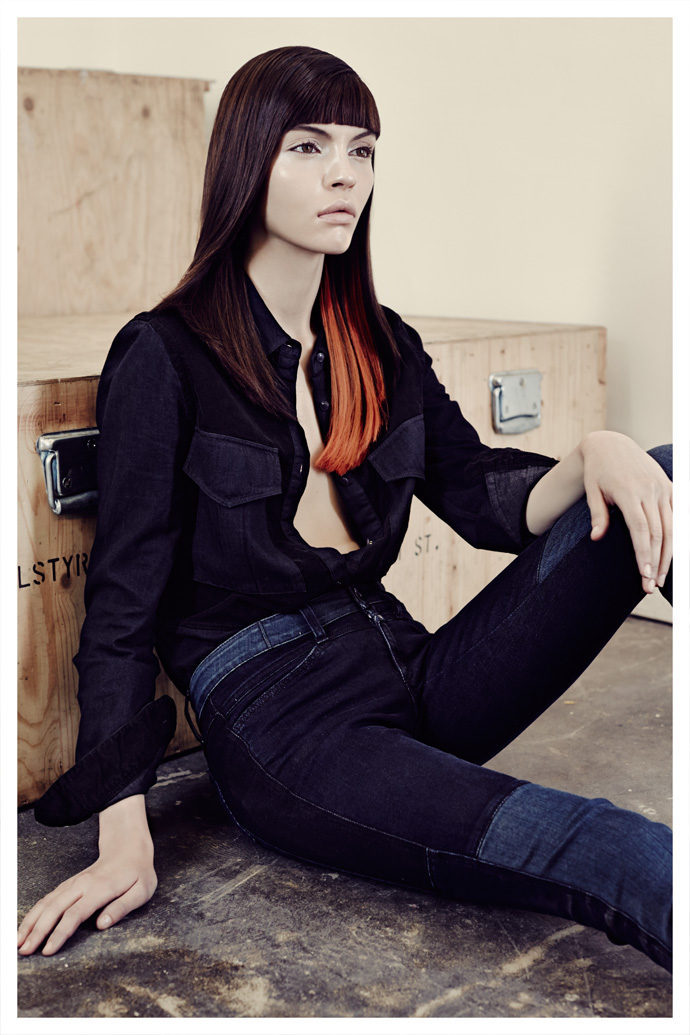
Shirt and Jeans FW 13/14 Kostas Murkudis for Closed. Photography by René Habermacher
RH: You’re working for quite some time in fashion now. When you started, fashion was something different: in the 90’s, fashion still had a socio-cultural context, was a compass and expressive part of movements. Today it’s different, its not really that a social movement expresses anything through dressing codes.
KM: That’s true and has obviously social, socio-political, and sociological causes. There is very little happening that could tempt for re-orientation. I do really hope that finally something will be happening. Or has it started already? When you look what is going on in Brasil, or Turkey, in countries where I would not have expected that this kind of movement would be surfacing.
The situations in Greece, Portugal or Spain, France and possibly soon England, don’t look so great either, but something is happening and I am hoping very much that this will spread across cultures and regions, and maybe create the necessity to develop new codes. Obviously they have to develop themselves, we as designers can’t help it.
RH: For quite a while fashion hasn’t had a cultural value of progress, it has become more a simple “garment industry.”
KM: That’s right. Fashion is not allowed to be like this anymore. It’s the very capitalist approach to define success only through growth, to which the big houses are forced to: generating work, circulate money, this and that – it’s not about content at all. In fact it is even arbitrary who designs. It is the brand with its margin that is in focus.
If that’s what’s thriving in society, fashion can only be its image.On the other hand, design has become another aspect – let’s take an example like the iPod, or the iPhone and what has been generated here: a simplicity, practicability and a beauty of objects that have not been produced like this in a while.
It’s not about developing funky variants and decorations, but to work continuously on refinement and improvement with every generation, which I believe impacts our everyday culture. Even kids are not seduced to just buy something new because there are some new crazy buttons added. And you don’t have the desire to buy a jeans with 25 embroideries and absurd stitchings on the butt that are completely pointless. This pointlessness, this battle of material is not working anymore.
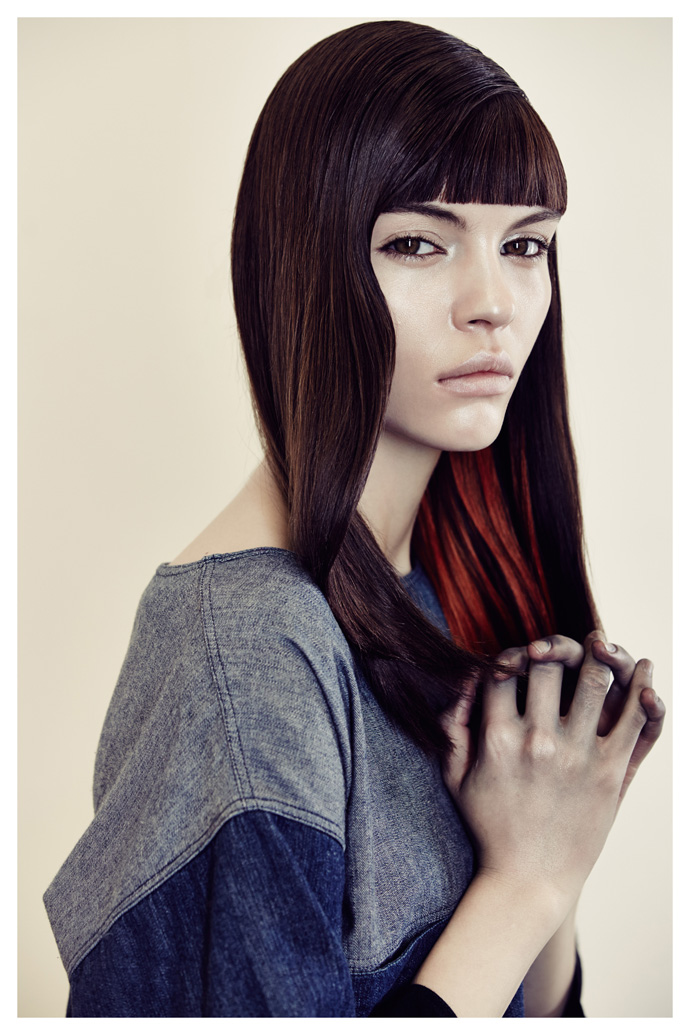
Jeans dress FW 13/14 Kostas Murkudis for Closed. Photography by René Habermacher „First there is nothing, then a deep void and finally a blue depth.“
Yves Klein.(Leitmotif for the colour codes to the SKYWALK CAPSULE COLLECTION No.1)
For example my brother Andreas, who owns a concept store in Berlin, he affords himself the luxury to buy only what he thinks is really good, regardless of the label. He buys what is up-to-date in his eyes. He was totally shocked about the pricing for which it’s possible to get good design that is on top politically correct produced in Italy: good quality fondly fabricated from great fabric. Not that this is world changing…
RH: But democratic?
KM: Democratic in a positive way. I didn’t really want to use that word. When my brother saw the Skywalk Capsule Collection in Berlin, he went to order straight away several looks from the FW collection, saying: “wow, this is really cheap- and so cool, but really cheap”.
Of course we have the same approach, maybe also because we grew up in the DDR: for us longevity or functionality and beauty don’t have to cancel each other out.RH: What is your relationship to glamour?
KM: I try to stay remote, but sometimes have to make compromises. My relationship is rather an aversion. I come from a very simple background and it really does not touch me to hear “who was where with who wearing what”, that doesn’t interest me.
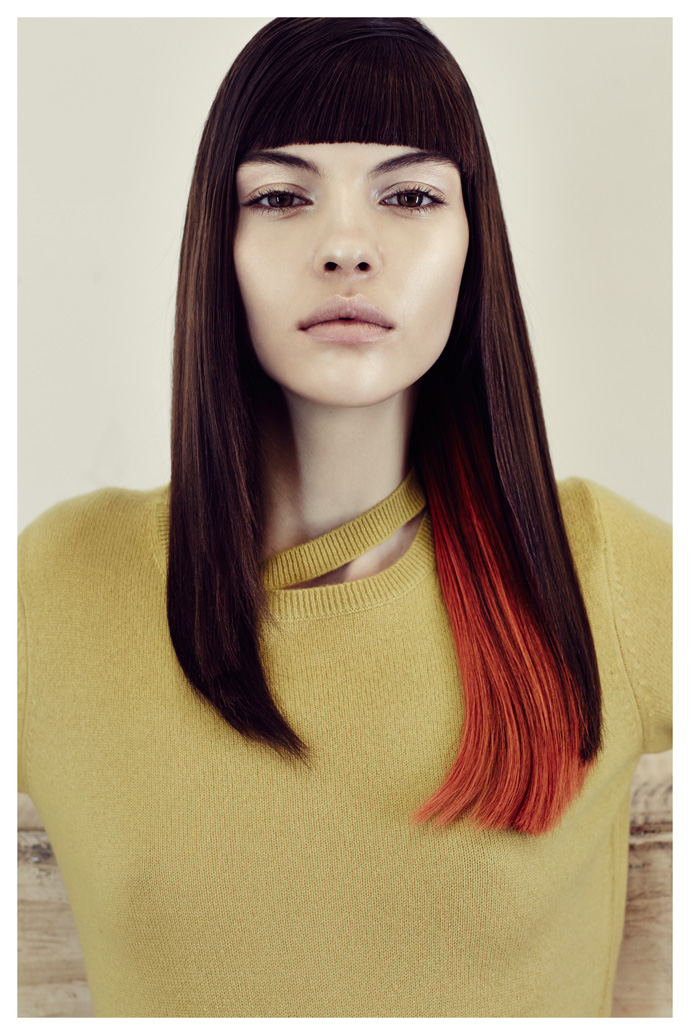
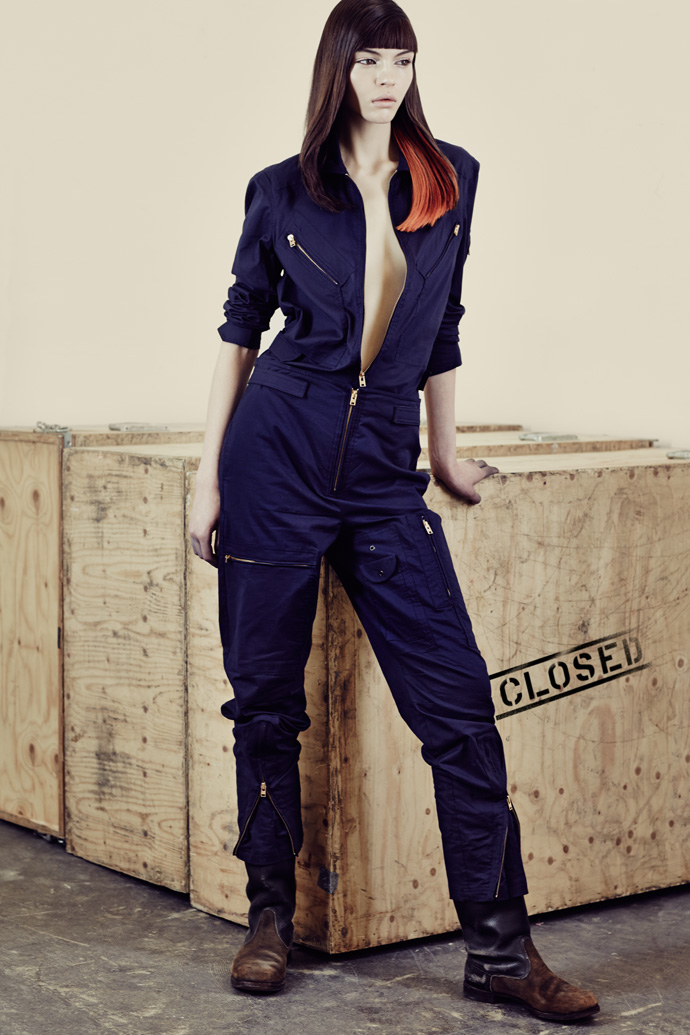
Right Side two pieces from the SKYWALK CAPSULE COLLECTION: Murkudis took inspiration from a vintage aviator suit, using the cuts and details to create a minimal wardrobe: a shirt, a blouson and pants for men and women. Boots: vintage DDR army. Photography by René Habermacher
„Earth is a delicate shade of blue“
Yuri Gagarin (Leitmotif for the colour codes to the SKYWALK CAPSULE COLLECTION No.1)
RH: Tell me a little more about the Skywalk Capsule Collection…
KM: The idea was based on the desire to bring the brand back to an international level, and the one of the brands defining aspects: the idea of unisex, that I thought very interesting and gave me also the possibility to explore menswear more, find a different angle and define their image more sharply.
Because the project was a very small range, I had to stay quite precise as well in material as colour and design, but it was the first time that I had the chance to show pieces that one actually can afford. If you look at the product, it appears at first sight quite minimal, even though its technology is actually very complex, which is something I wanted to put forward as well.
But because of all this, it was quite obvious to me to give the collection somewhat of a poetic moment.
RH: Yet here is also a practical thought behind it?
KM: Of course. It was to show the brand’s core, and a product that should function in the everyday life over long time.
Apart from that, the beauty of a product becomes apparent in its use, becomes part of our lives and our bodies. That’s what makes a jeans. It only becomes your jeans, and a great one, when it deforms on your own body, through use, through touch, through creases, through whatever. It becomes part of your being. That makes it truly beautiful when it is beautiful.
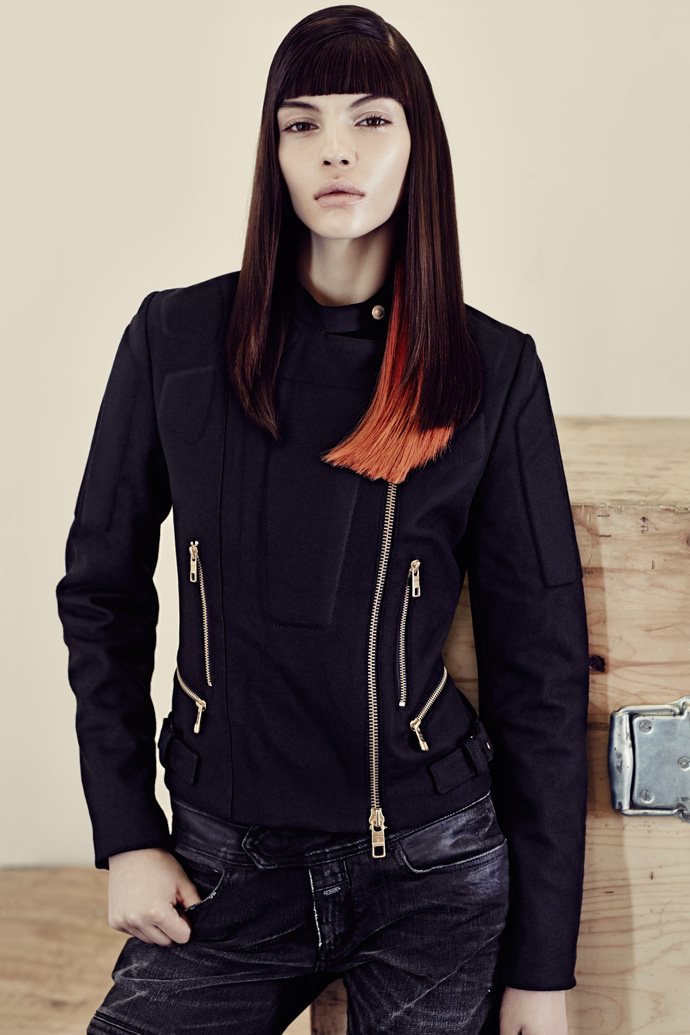
Felt Perfecto Jacket and Jeans, both FW 13/14 Costas Murkudis for Closed. Photography by René Habermacher
RH: With a clientele living in the most various meteorological conditions, does it really make sense today to produce season-oriented collections?
KM: This is a totally legitimate question. Also as we know that the big producers often deliver new products up to twelve times a year.
So for smaller brands it is indeed worth considering to orient themselves differently because they have no chance to stand up against this moloch of an industry.In a way we are overtaking ourselves with everything: when the sales start the season hasn’t even really begun, there is a resort collection, a pre-collection and a in-between collection- that is all a bit absurd. I see that with my brother, who says “I don’t need a pre-collection that is delivered in November when its perhaps snowing here and -30 celsius”. That makes no sense.
On the other side I am bound to the cycles of the classic way of producing 4 collections a year.
I think the problematics are there for everyone, but no one has yet found an ultimate solution, or takes the risk to say ‘I am going to position myself entirely new in this context.’RH: In your case do you do a presentation, or are you considering eventually a show?
KM: Right now this is not a real topic for us. Maybe next year or after that, it really depends on how we develop and what our expansion will bring.
RH: The one thing I find puzzling is with all the coverage on the shows, once the products are in the shops, you are already bored of them.
KM: I totally agree with you that three weeks after the shows you vaguely remember and when the products are delivered to the shops you practically forgot about it all. This wish and desire to own the pieces immediately is fading in that period.
But that’s what you have Zara for: they deliver within three weeks after the show a dampened version for those who can’t wait at all and never really got it anyway: those will buy the cheap copy (laughs).
By then the others just saw the newest collections and are wondering that they have ever liked the current one…. I look at this smiling.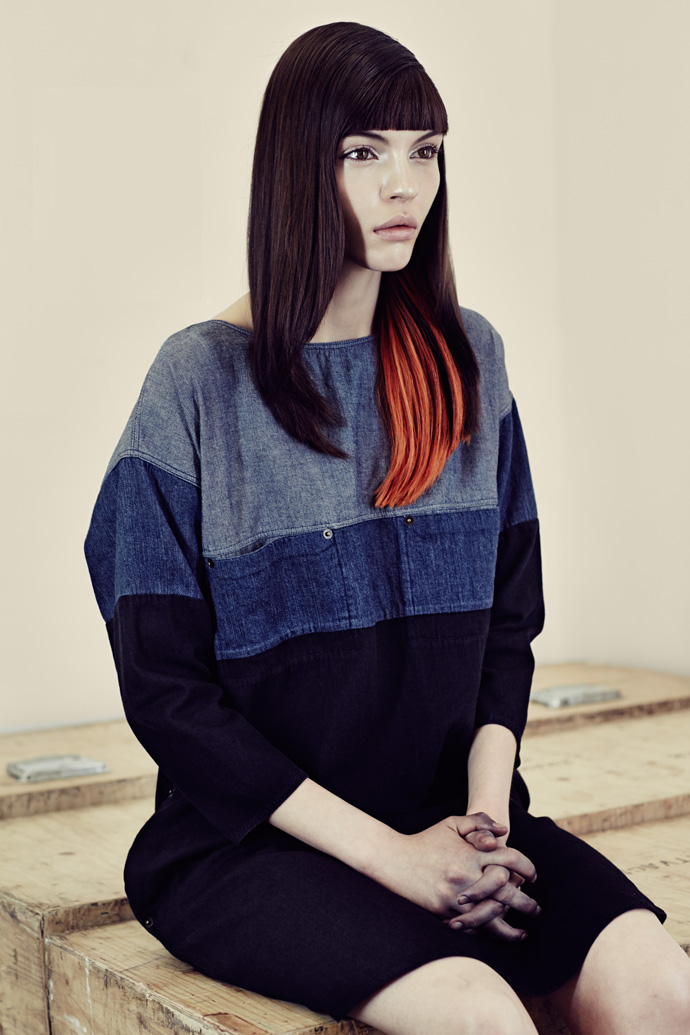
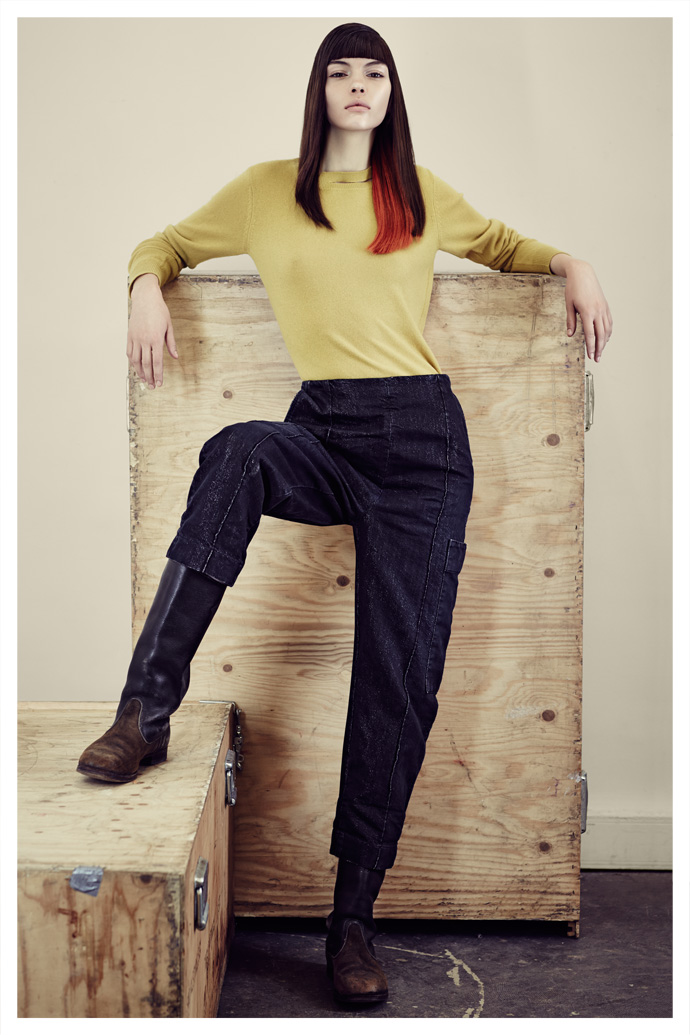
Left: Jeans dress, Right: Split neck pullover and Jeans, all FW 13/14 Kostas Murkudis for Closed. Boots: vintage DDR army. Photography by René Habermacher
RH: You do have a special relationship with Japan, is that right?
KM: Yes, when I was a small kid, I started to do judo. I had a fantastic teacher that I absolutely worshipped as a living hero.
I was excited to wear these suits, the belts. The scent of the mats, the bows, this outlandish language had fascinated me. To me it was of course an escape from my Greek moulded DDR prosaicness and the pressure to perform. I did virtually absorb all these words, ceremonies and preserve within for years.When I started to be interested in the arts I read a biography of Yves Klein, and realised he was a judo master like me, and eventually lived in Japan. I think his work was to some degree influenced by Japanese moments, in their simplicity and splendidness. This has really accompanied me ever since. The Bauhaus would have been unthinkable without the Japanese influence. In many aspects this influence has developed with me, the desire towards the exotic but as well the austere, the sophistication and the celebrated. The handling of colours, surface but also the poetic moments and the spiritual aspects behind.
I celebrated plenty successes in Japan and grew with these, so I owe a lot to the Japanese. We found each other. I was always fascinated and excited about it, to the point that Gordon, one of the owners of Closed, and I started to take Japanese lessons.
This hunger is not satisfied yet- and will always find itself in my work again.
RH: What is the last thing that stimulated you?
KM: I was very inspired by the exhibition of Martin Kippenberger: the incredible freedom of a man in dealing with the most different tools. I have great respect for his state of mind that moved me to tears of joy. I haven’t laughed that much for a while. All my senses had been spurred through this.
This interview and photographs are a Stimuleye exclusive
interview and photography RENÉ HABERMACHER
fashion editor SUZANNE VON AICHINGER
hair JONATHAN GEIMON @ AIRPORT AGENCY using Bumble and Bumble
make up MIN KIM @ AIRPORT AGENCY
model KATE B @ NEXT MODELS
thank you VERSAE VANNI @ NEXT PARIS
and LIBRAIRIE Ofr PARIS for your support -

valli mythologies
-The Stimuleye presents a new film for Giambattista Valli’s fifth haute couture collection for Fall 2013, following last season’s Jonas Mekas-influenced film The Other Side of Paradise.
This season, the themes are goddesses, fine porcelain and… Lee Radziwill makes a sublime and subliminal appearance.
-

undercover (and inside out)
-Japanese designer Jun Takahashi, the creative force behind the cult label Undercover has been a major influence in Japan’s fashion scene for more than a decade.
After vanishing for two years from the Parisian catwalk, he returned with a vengeance and presented his new collection to an audience that awaited his return, with mix of patience and restlessness.
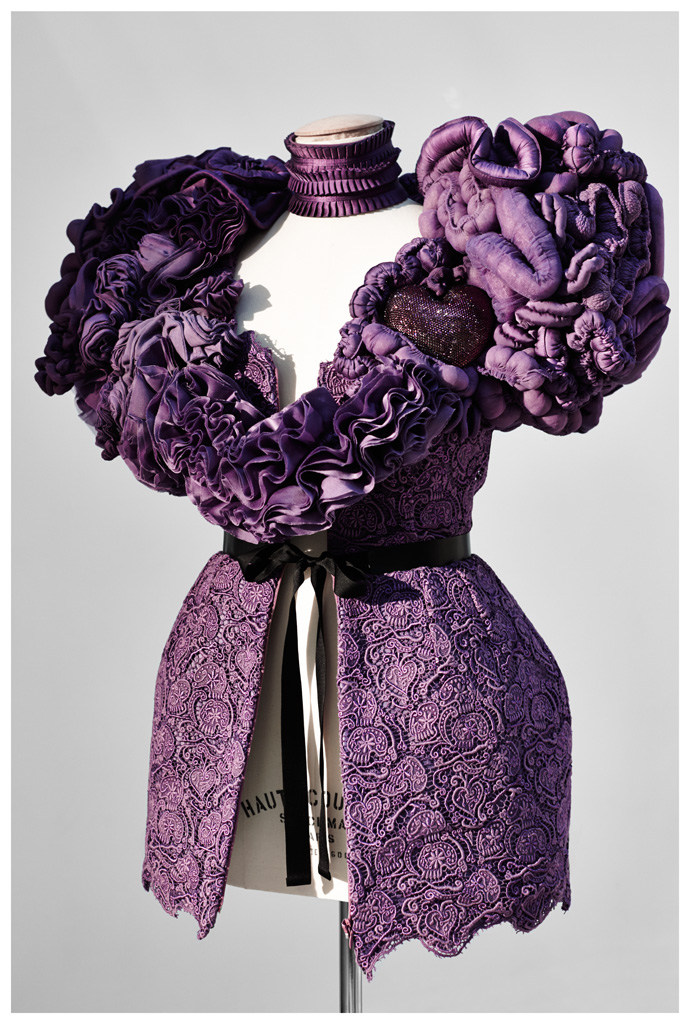
Inside out: Undercover dress with entrails, bone and skull lace, a heart on the right spot for the scary cute. Photo by René Habermacher.
The show at the intimate venue of the Institute Pasteur started with much delay, yet the undercover flock of disciples, among them the devoted Grace Coddington, awaited patiently what was to come from behind the antique glass-panelled doors: scary kittens with bunny masks on ponytailed shoes, wearing their insides out, ribcages and organs on outer display. Skeletal hands grasping waist lines, vintage lingerie elaborately piled-on to sleeveless evening jackets. Little dresses with what seemed to be ruffles at first glance, turned to be a romantic interpretation of entrails slung around the décolleté and a sparkling crystal studded heart.
Surprising,- or in the case of Jun Takahashi actually not- the arch from the drama of the unique pieces to the extremely wearable parts of the collection: googly eyes on a waxed trench coat, or the return of Undercover’s signature pieces, the perfecto, and the trench, with double collar and worn as a dress.
This is where the strength of Jun’s subversive vision lays: there is no friction between the everyday pieces and the elaborate constructed parts of his universe. Seamlessly he migrates between outfitter to the urban hipster to action art performer creating his giant Grace dolls from vintage plush toys in front of a bedazzled audience. The Graces, creatures from outer space were originally created for the presentation of the Undercover collection SS09 became somewhat of the labels mascot.
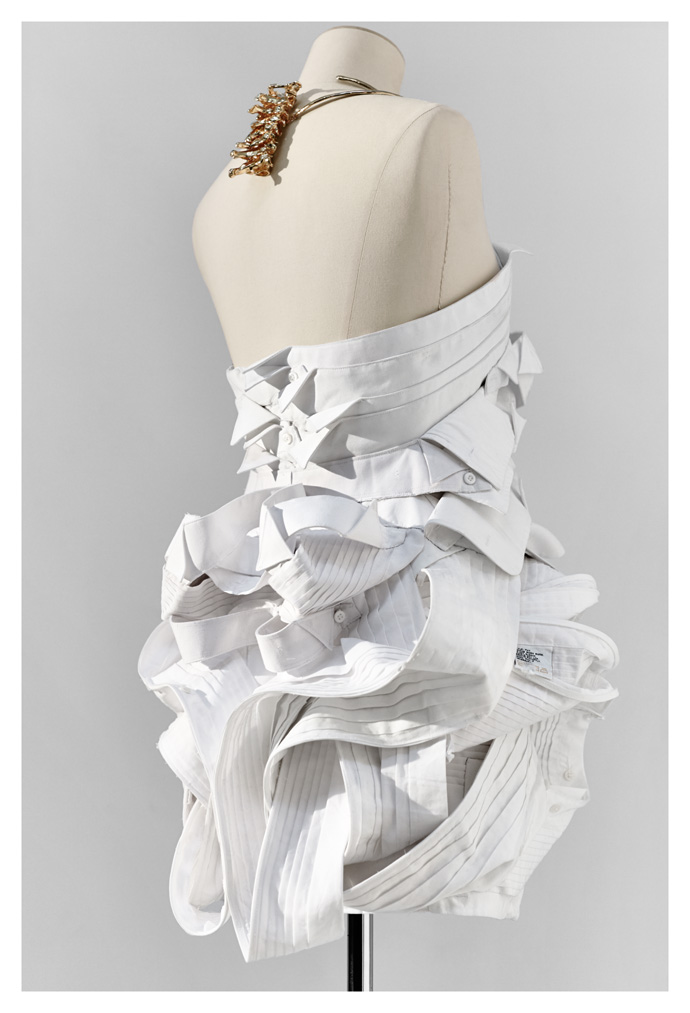
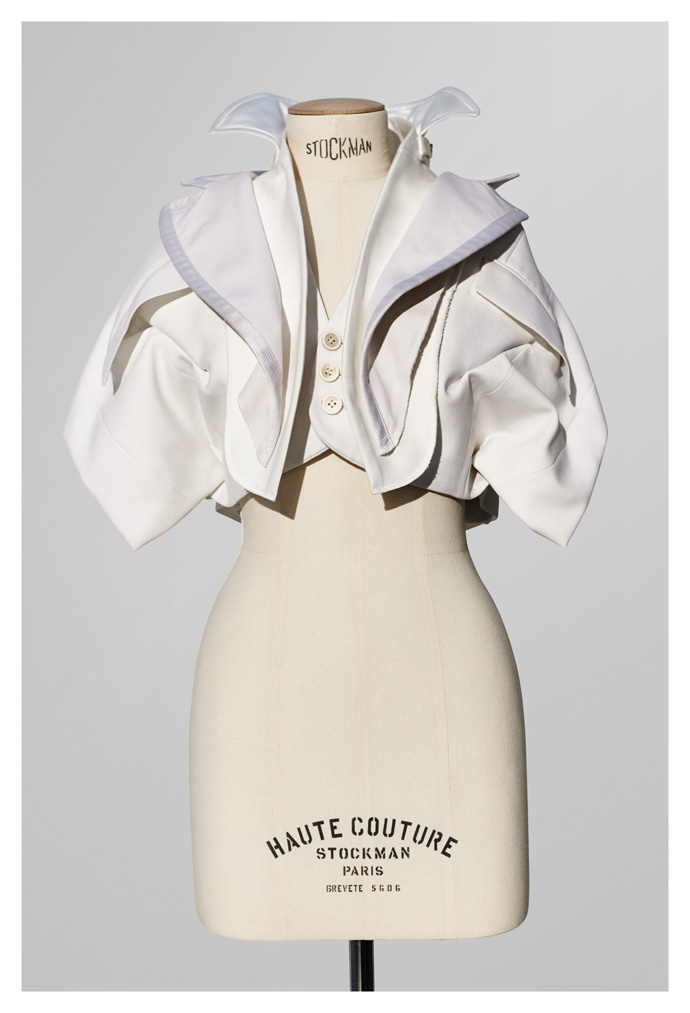
Starch undercover: special pieces made from deconstructed men's white shirt collars. Photo by René Habermacher.
René Habermacher: How is it to be back in Paris?
Jun Takahashi: It’s very exciting! Its been two years since we had the last show, so I am so happy!
You received well deserved great critics for this show of return.
how did you start with this collection, and how did it evolve and what is the narration?Last season when we came back to paris having just the showroom, I made seven special crafted pieces. It’s been a while since I’ve made such a creation and enjoyed it a lot.
It was just for the showroom, but this season i wanted to present a collection on the runway to show it to a broader audience. That’s how I started this collection.
The theme of the collection is about internal organs and bones, showing something from the inside exposed to the outside. Like lingerie that is usually hidden underneath, I used to make dresses and so expose them to the outside. That’s kind of the theme of the collection.Why did you decide at this moment to take the inside to outside?
I don’t know why (laughs). It’s been a while I wanted to show the “inside”. This is very undercover. It’s easy to express “Undercover”.
The motifs of organs and bones have something grotesque and scary in peoples minds. I take this and make it cute. It’s about both sides: not just scary, not just cute. we have both sides in the brand.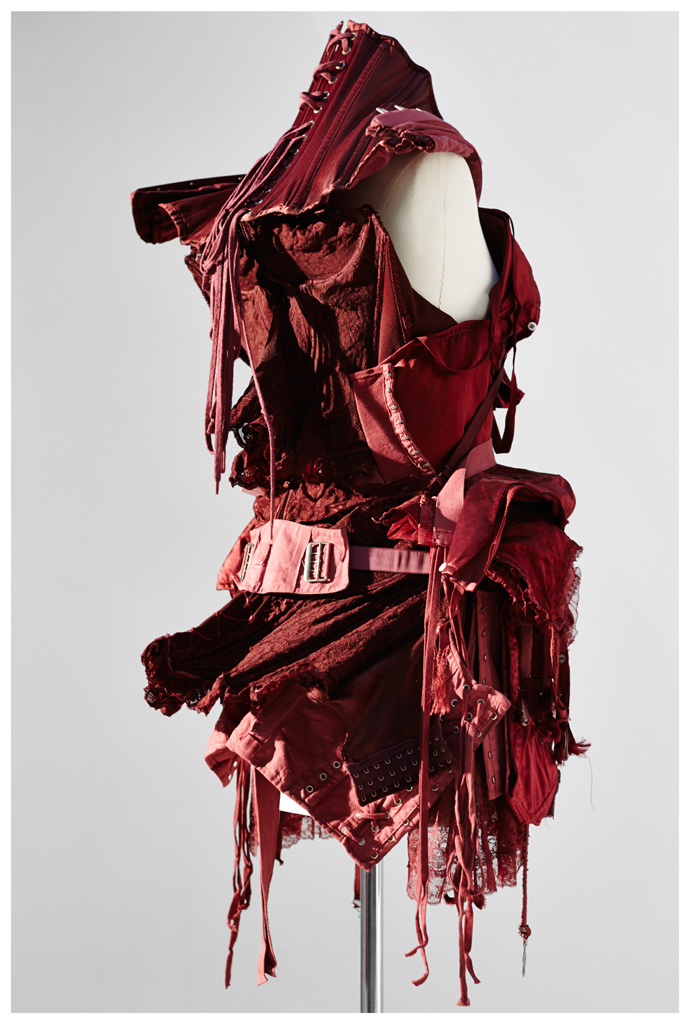
Pile-on vintage lingerie evening jacket. Photo by René Habermacher.
Are you a story teller?
(laughs) To me show is one big story, one drama, one stage. In a way I am not just making clothes, but one big tale, a story.
Since I was little I preferred the scary stories. I like Hitchcock movies. I am not necessarily into the ghostly but prefer the mental story.Another aspect is a strong sense of subculture evident in your work.
It is very different today then when you started off. What is subculture for you today?Most of he people surrounding me in Tokyo come from subculture, its a normal thing for me – its music, movies etc. not the mainstream. People in subculture are not specifically specialized in something – they don’t have mass-apeal. I like that. I source from this and then present my version in the “mass-area” like Paris.
Do you think exposure is dangerous for subculture?
The dark side of sub-culture! (laughs)
I take this positive. We always want to have information very quick- and I find this bloggers taking snapshots in the street very interesting, it’s really like I use the internet. How quick they are, it’s impossible for the print to catch up. Myself I like to post on Facebook and use the internet as a communication tool.Is the “season” still relevant to you?
When I design i don’t really think of the season. But when it comes to selling, we have to take this into consideration. For example in Japan we start selling FW collection in July, which is very difficult to sell Winter clothes because its still very hot for another 3 months until October. So we have to think about the balance between the creation and the business. So that’s difficult. We cannot completely ignore the seasons but not only thinking about seasons.
The runway shows’ timing are getting earlier and earlier and it takes time to actually get in the store.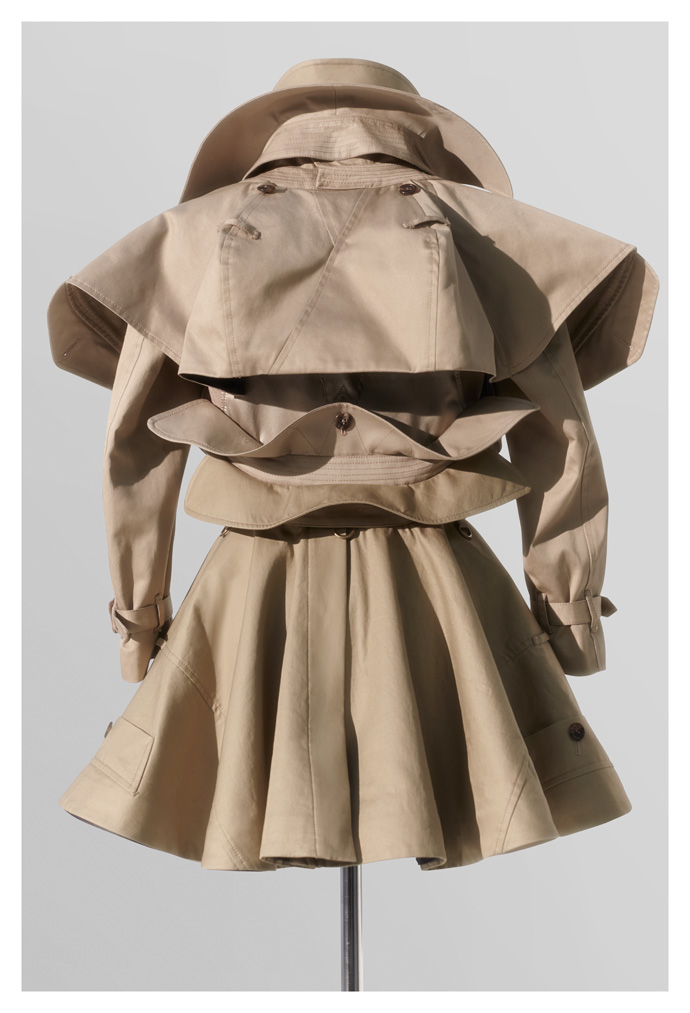
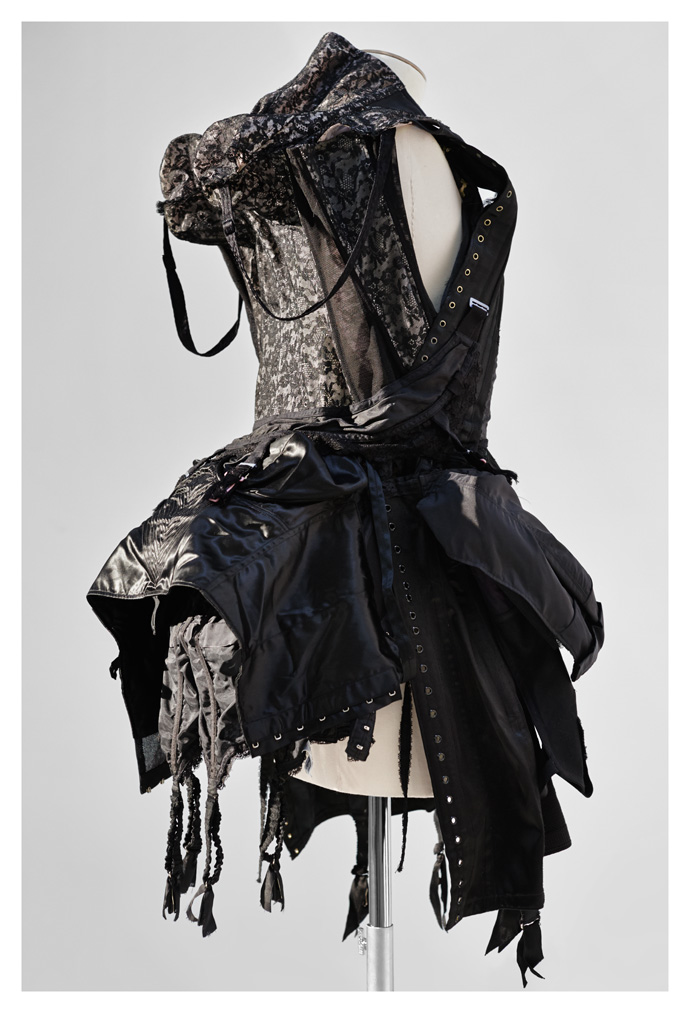
Undercover signature: the trench. Right: Pile-on vintage lingerie evening jacket. Photo by René Habermacher.
How is Japan to you today with the changes the country had been affected with the tsunami and the Fukushima incident especially?
Since the disaster was such a big thing and with the economical situation everybody’s feeling was like “hit the bottom.” We cannot be worse anymore. But now the people are actually trying to go up to be positive, they step back and reflect what can we do to recover from such a disaster. Maybe the government is not helping us that much, but people are trying to do something themselves, try to get the economy back and be positive.
How do you imagine the future your kids are growing up into?
They are little kids right now, but they are starting to have their own will where they wanna go. I am not so worried about them because they will find a way by themselves. We’re concerned about the future and the nuclear problem in fukushima, the earthquakes and what kind of effect this will have on us, but my kids will find their own way so I am not too much worried.
Are you still telling your kids stories of Grace? How is Grace, will we hear again from your creature?
I will continue with Grace- but Grace is not for little kids. They get a little scared… with one eye and all that.
I have a Grace doll in my house but at the beginning the kids were a little scared.But if you were a kid you would not be scared…
It’s scary – but there is an attraction too!
What’s next?
Showing the next collection in Paris again!
What is the last thing that stimulated you?
So many various things! conversations with friends – it’s not just one – it’s many different things.
I absorb everything. Family and friends are important. It’s important to have close friends that are straightforward in their opinion what they think about me, instead of just hiding things. It’s important to me to listen to them. A lot of my friends are creators, photographers doing their own thing. Their opinion is very important to me.
As I get older I get inspired and stimulated by more and more things. I can accept anything like a bus ticket.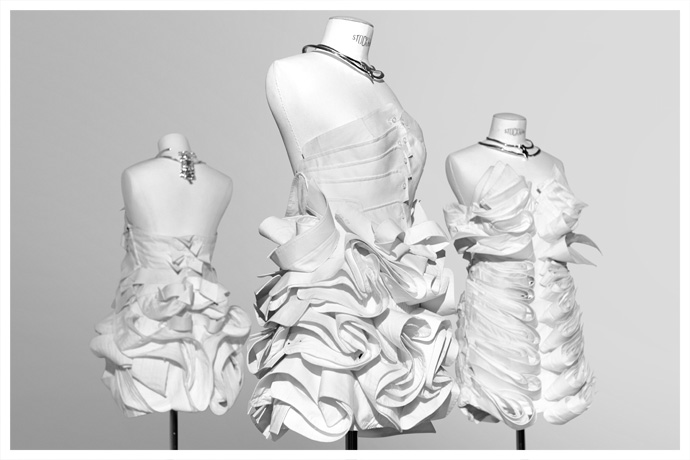
Trilogy in white starch: dresses from deconstructed men's white shirt collars. Photo by René Habermacher.
http://www.undercoverism.com
-

john lawrence sullivan : in the ring
-Tokyoite Arashi Yanagawa, the man behind menswear label John Lawrence Sullivan, has quickly become a fixture of the men’s fashion circuit.
The choice of name for the label is perhaps the most telling. John Lawrence Sullivan, the man, is a heavyweight boxing champion, also known as the “Boston strong boy,” and godfather of sorts to Arashi, who quit a promising boxing career to fight in another type of ring.
Ever since entering the seasonal arena of fashion week in Paris, he’s championed his collections in the eye of attention, with the likes of Suzy Menkes a constant follower. In this context, Arashi’s unconventional vision of the sharp tailored sportsman is most compelling.
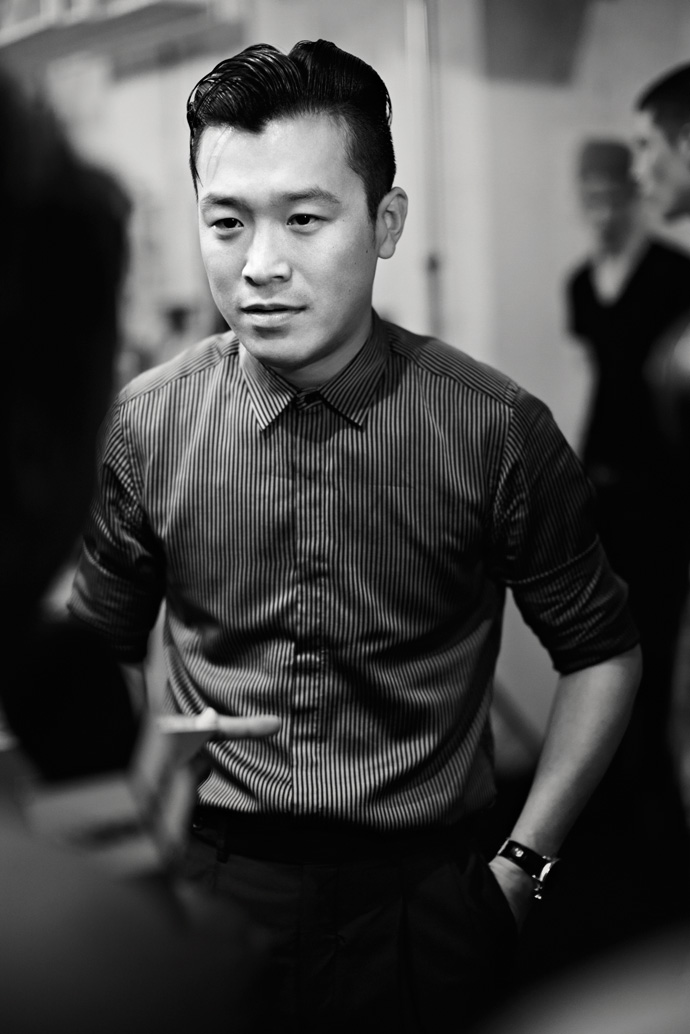 Arashi Yanagawa backstage after his John Lawrence Sullivan presentation. Photography by René Habermacher
Arashi Yanagawa backstage after his John Lawrence Sullivan presentation. Photography by René HabermacherRené Habermacher: Hello Arashi, how is it being back in Tokyo after your last show in the ring fight of Paris fashion week?
Arashi Yanagawa: I’m getting ready for the next match in June. While I’m always relaxed in the end, I also always begin thinking about the next collection right away. It’s exactly the same as in boxing.RH: In your work, specially your most recent collection, I sense a strong fascination with British culture.
but you’re successfully showing your 3rd collection, you chose Paris to present it…
AY: I believe Paris is the most important location for fashion in terms of the both the culture and the history of the industry. Paris has a special eye for beauty and elegance. No other place draws as many journalists, buyers, and fashionistas. All of this naturally makes Paris a very attractive city for presenters, but I also appreciate how strict everyone in Paris is towards creativity.RH: And what is it with you and London?
AY: London has street fashion just like Tokyo, but it also brings history and tradition into the mix. I’m impressed by the way all of this culture has just naturally rubbed off on the younger generations. Another example of something that has really moved me is the culture of the London market where you see young people today buying and even demanding clothing designed a century ago.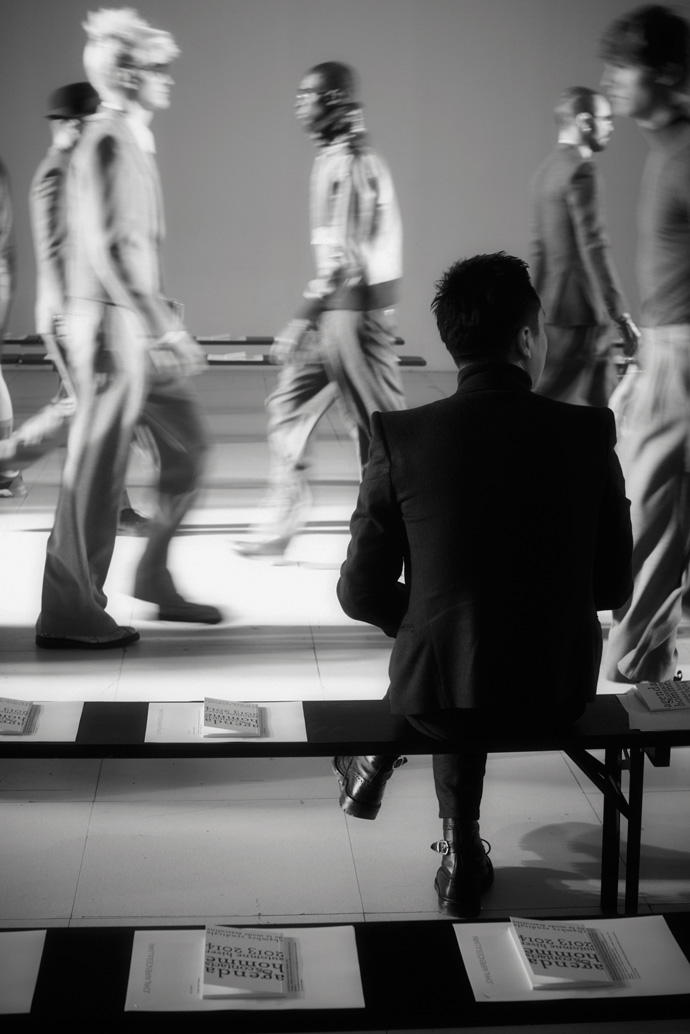
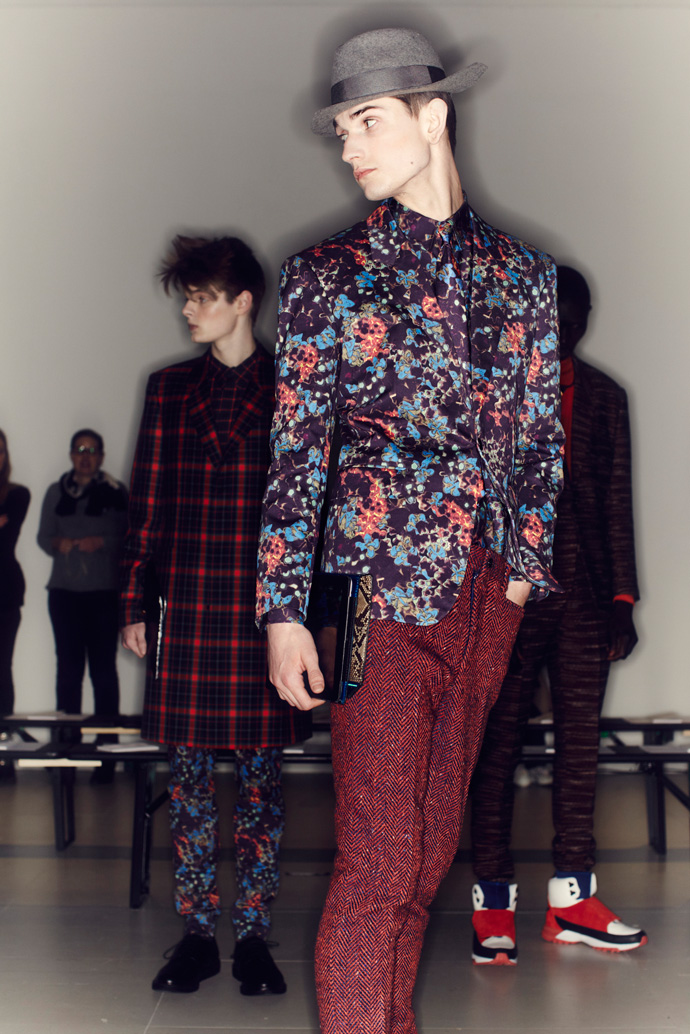 Rehearsals for John Lawrence Sullivan FW13. Photography by René Habermacher
Rehearsals for John Lawrence Sullivan FW13. Photography by René HabermacherRH: how do you decide for what you’ll go next? what is your creative process?
AY: I input the “sense” of the things I see or hear in my daily life and stockpile them. These could be colors, silhouettes, light, or even materials. But, I make an effort to express my own sense of the now rather than just making things based on historical research.RH: For the current summer collection the theme was influenced by the Bauhaus movement.
Why did you feel the urge for this now, and how did you translate that into the clothes?
AY: I had a chance to go to Berlin, so I paid a visit to the Bauhaus school in Dessau and took in the artwork there. I found the combinations of wood, leather, and metal used in the products there particularly interesting, and thought it might be fun to try doing the same things with apparel. So, I made the theme “Bauhaus” and began putting together the collection while referencing architectural cutting, artistic colors, and product techniques.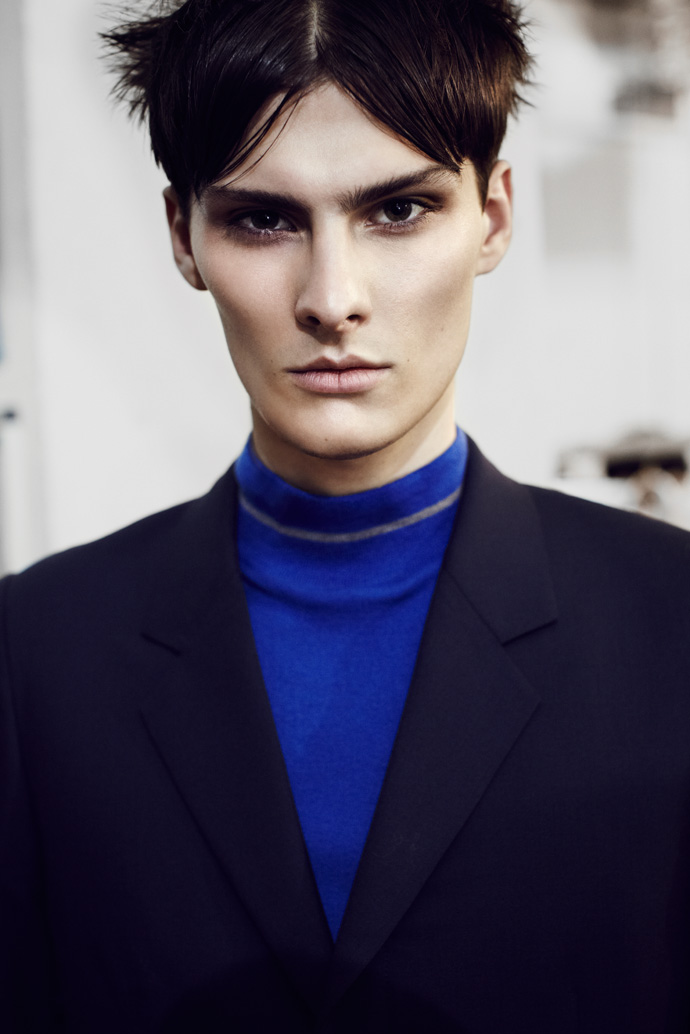
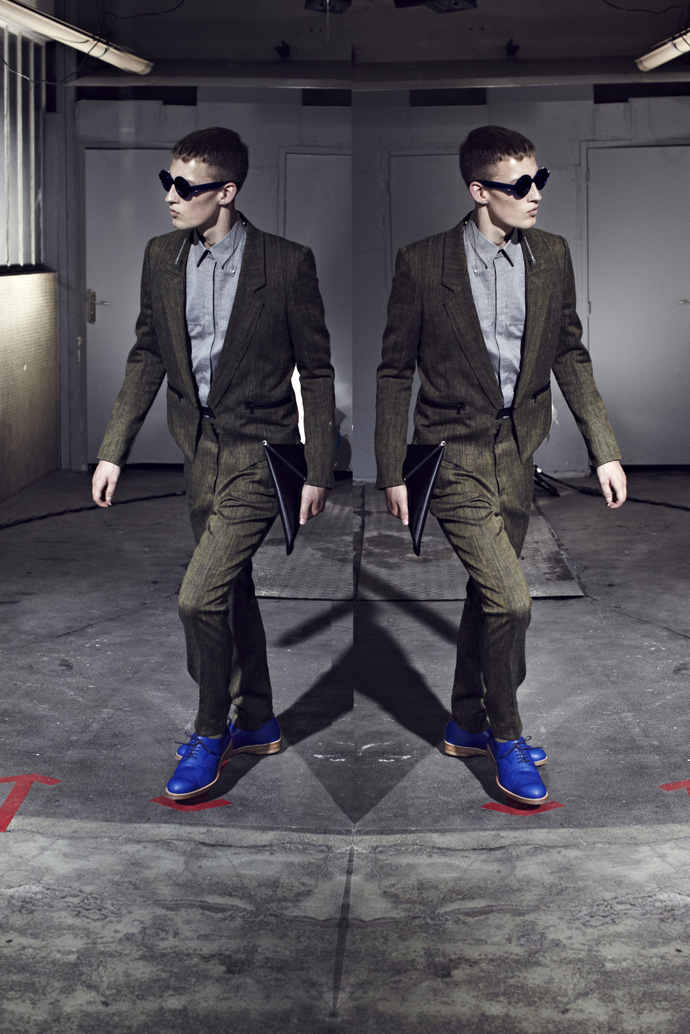 John Lawrence Sullivan's "Bauhaus" inspired collection, SS13. Photography by René Habermacher
John Lawrence Sullivan's "Bauhaus" inspired collection, SS13. Photography by René HabermacherRH: can you tell me more about “ELECTRIC AFRICA”: theme of the collection FW13/14, you just showed in Paris, what ideas are behind it?
AY: “Electric Africa” is a coined phrase. I had the idea to create a new, modern vision by combining tribal patterns associated directly with Africa with flashy colors instead of the standard earth tones. Tribal (triangular) elements were worked into various items and aspects like the cutting of the tailored jackets or the placement of the buttons. I also added a spacey essence reminiscent of the crop circles that suddenly appear in fields to the accessories, colors, and textures.RH: This collection also sports extraordinary footwear. Your sneakers have been hailed throughout. How did this design come together?
AY: I wanted create something akin to sneakers or trekking shoes, so I used Vibram soles. I also combined the base colors of the seasonwith highly contrasting hues in order to bring out a sense of Africa. I worked with a brand called ORPHIC when making the shoes.RH: Since you dropped your boxing for founding your label, fashion in Japan underwent quite some changes. How do you see the japanese approach today, what is your viewpoint and what influenced you over the course of time?
AY: When I started my brand in Tokyo my image was much more aggressive. I feel like back then many of the magazines adopted a fashionable approach, and that the buyers tried to answer the challenges the designers undertook with respect. But, as the economy got worse the magazines switched to much more easy to understand catalog-like appearance in order to make sales, which in turn influenced buyers, whose customers were influenced by this, to become much more conservative in their selections. So, there were a lot of negative things occurring in fashion here. The Tokyo runway shows were no different, as the focus shifted conspicuously to more “real” presentations rather shows with a bit a fantasy or elegance to them. Feeling all of this made me want to do my shows somewhere more stimulating, so I chose Paris.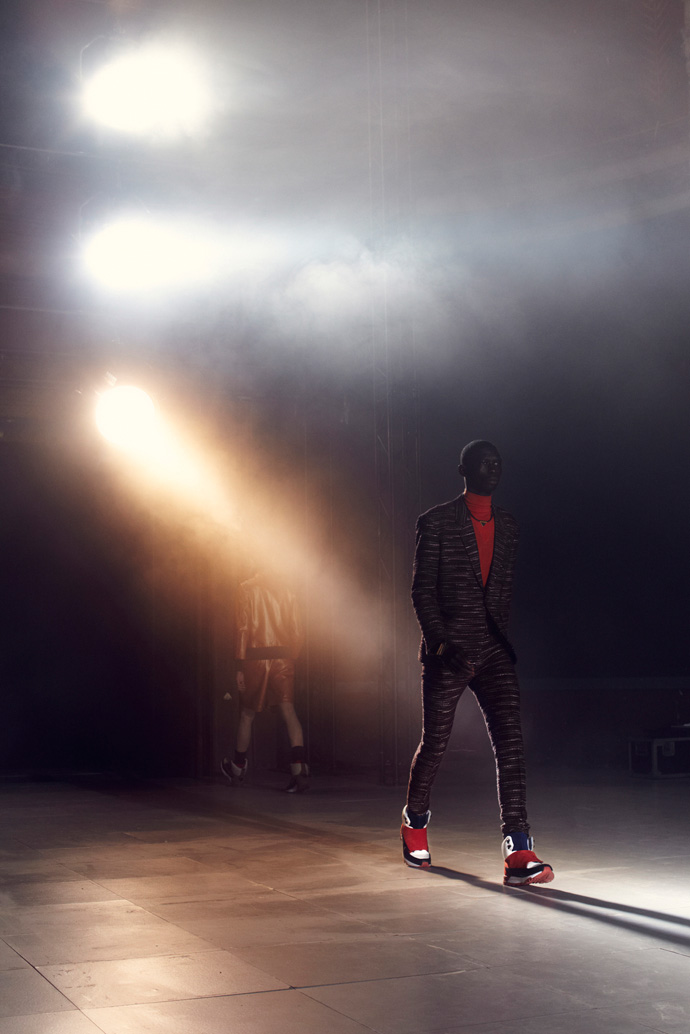
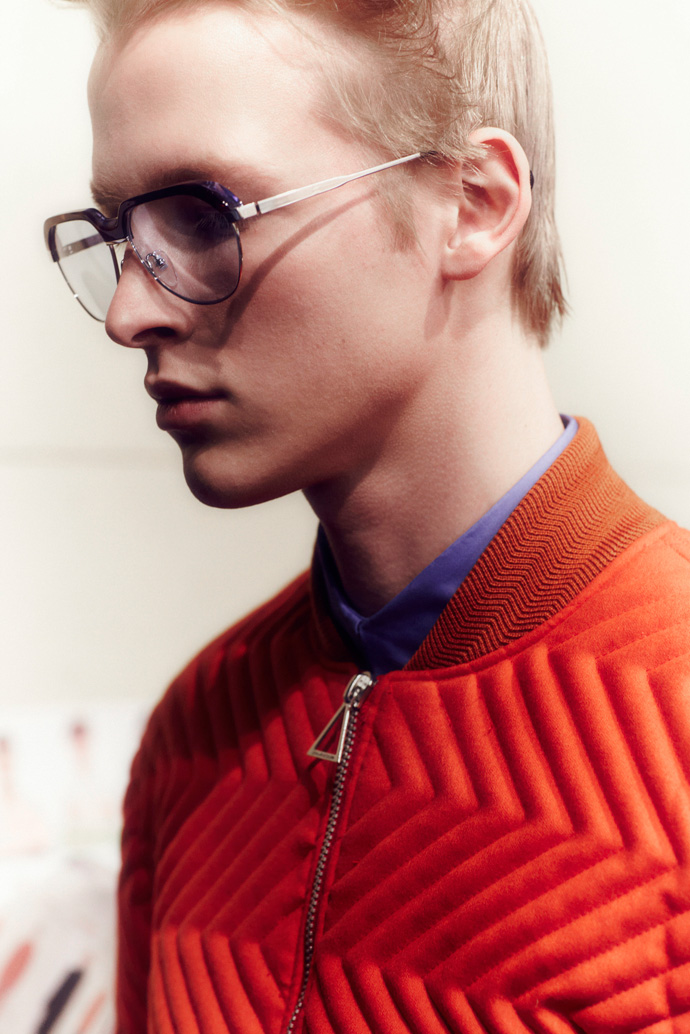 "Electric Africa", John Lawrence Sullivan FW13. Photography by René Habermacher
"Electric Africa", John Lawrence Sullivan FW13. Photography by René HabermacherRH: While developing your collection, are you having a specific type of man in the back of your head?
AY: I always imagine a man who possesses both beauty and strength in terms of appearance and mind. If I were to provide a sportsman as an example, there is a certain boxer who comes to mind…RH: Are there any parallels you can draw between your sports career and the one in fashion?
AY: One thing I realized when I first started working in fashion is that there is a common trait shared by boxing matches and fashion shows that only I seemed to notice. This was the way in which you worry over something that will last only few minutes on a single day for months in advance, battling with your anxieties and, as long as you don’t give up, preparing for the next match as soon as it’s all over regardless of whether you won or lost. The way everything seems so fleeting and transient once it’s all said and done is also the same.RH: The understanding of classic tailoring is a very strong element in your work. Now you started your women’s line: how does this apply here?
AY: Incorporating classic tailoring into women’s fashion is one of the most important elements for John Lawrence Sullivan. This isn’t something just any brand can do, so it’s something we will continue to actively working with in the future. One of the differences between men’s and women’s fashion for me was the way in which things like esthetic elements concealing points I had complexes about confused me a bit at first. Now I feel that I have learned to use men’s techniques to deal with these things.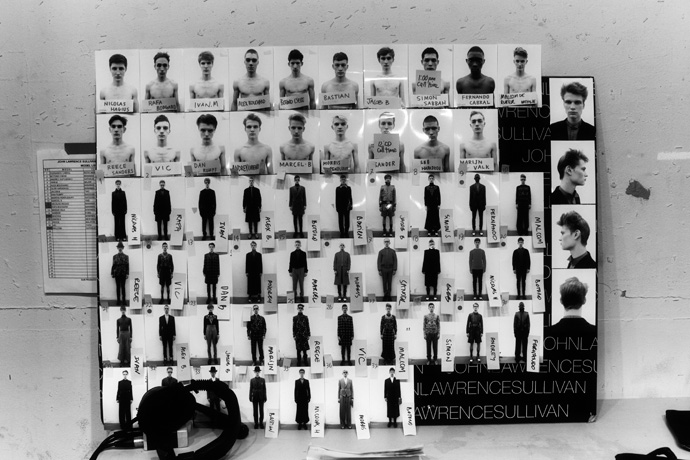 Showboard with looks and cast for "Electric Africa". Photography by René Habermacher
Showboard with looks and cast for "Electric Africa". Photography by René HabermacherRH: As you added another collection to your house – your work wheel must spin faster evidently, with 4 instead of 2 presentations.
AY: I always think of how I can break down the restrictions of the tailored look when I do my men’s designs. While there is the sense that I can be confident in breaking these restrictions down precisely because they exist, but with women’s my process is one of imposing my own restrictions on the things I design freely. So, there is a sense of mutual stimulation between my men’s and women’s lines that has been a good influence in my opinion. That said, I am definitely much busier than before…RH: Do you feel urged by the increasing numbers of pre-collections and cruise collections that the big houses lately launch?
AY: This is most likely just a sign of the conservative sales trends we’re seeing worldwide right now.The big houses are just doing this as a way of making sure they continue to pull in revenue. I too feel that JLS must do the same if we are to continue showing in Paris, so I’ll be considering various strategies for this in the days to come.RH: With clients all over the globe in different climate zones: do “season oriented” collections make still sense to you? (already the weather in Japan is quite different to the north american or european)
AY: Breaking things up by season allows designers to change up their mood and add depth to the presentation, so I most definitely think it has meaning. But, I also feel that in terms of actual sales it is often seasonless items that perform the best.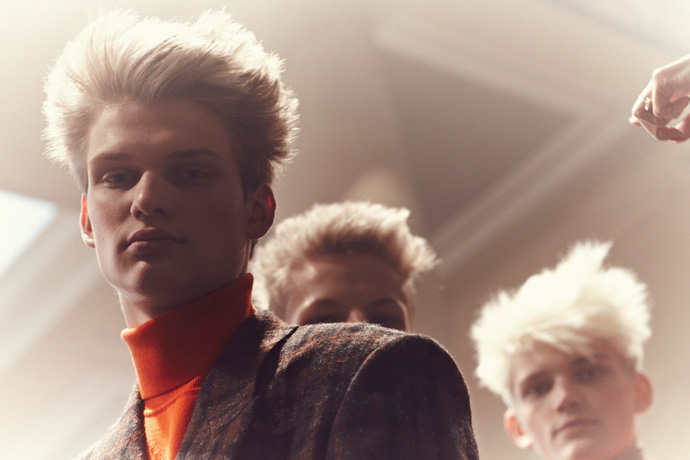 "Electric Africa", John Lawrence Sullivan FW13. Photography by René Habermacher
"Electric Africa", John Lawrence Sullivan FW13. Photography by René HabermacherRH: How do you perceive the present of fashion?
AY: I think what we are seeing is a mixture of various styles coming together.
This is also exactly why I feel that you can’t make it in this day and age unless you believe in yourself and keep making bold presentations. I guess you could say I feel we’re in an era where only the essentials survive. I want JLS to continue to be a brand that always takes up the challenge of presenting in Paris.RH: What is up next?
AY: The designs for my women’s exhibition in March and preparations for the 2014 S/S season.RH: What is the last thing you saw, read, heard or felt that stimulated you?
AY: Tadao Ando, James Turrell, Donald Judd, Taro Okamoto, Talking Heads, Pixies, David Bowie, Wes Anderson, Jim Jarmusch, Kinji FukasakuWebsite: John Lawrence Sullivan
-

MONSIEUR HERVÉ
-What’s in a name ?
You can ask Kenzo Takada, Martin Margiela, John Galliano, Valentino Garavani or Helmut Lang – designers who, for various reasons, left the company which bears their name, and then had to make themselves a new name, in fashion or elsewhere.
Or you can ask Monsieur Hervé Léger, the legendary French designer who took fashion by storm with his body-conscious designs, ultimately embodied by the “bandage” dresses. Monsieur Hervé Léger does not design for Hervé Léger, the company. Monsieur Hervé Léger designs for Hervé L.Leroux, a nom de mode suggested by Karl Lagerfeld.

Photography by René Habermacher
Filep Motwary, who met Monsieur Hervé through model and muse Suzanne Von Aichinger, talked with the designer as he prepared his new couture collection for Summer 2013, now on display in Paris in Colette and on presentation in Monsieur Léger’s new but history-laden atelier.
Filep Motwary: So, how is your day so far?
Mr. Hervé Léger: Well it’s cool. I am peaceful today. Yesterday I was not, but today I am.F.M: You are getting ready for your Couture collection ?
Mr.HL: Yes, you see I am a professional, I try to do everything in the right context and I do not like to keep my people working at night and we are trying to be efficient and of course we will be ready on time. You know I’ve been creating for a long time, but because I didn’t want to make shows, my comeback is under new conditions. And it figures that some people always followed me and now I sell worldwide. Business is good now finally again and I am pleased.(As we speak, Suzanne Von Aichinger and René Habermacher are working in the showroom photographing the garments),
F.M: I understand. Do you mind if you help me fill some gaps of your life’s storyline, because it’s out there, but not fully completed… So, it was during the late 1970’s that you started-off your career as a hat maker and hairdresser?
Mr.HL: (Laughs) It’s a crazy story, but… I’ll try to make it short. I had done some studies like everyone, I went as a young man to the Beaux Arts in France though I only stayed for one year as it was the 70’s and France was all about manifestations at the time and intense political changes. As students, we were on the streets demonstrating and I wasn’t learning a lot since everything was on strike.
I also wanted to be independent from my parents and wanted to do something by myself, to work. I am very good with my hands; I am a craftsman and can do everything with them in terms of creation so I decided to be a hairdresser. Although I didn’t study hair, I learnt the job very quickly by opening the door of a hair-salon telling them I wanted to learn. They took me and stayed there for a while. Then I started to make hats, after finding a book at my grandmother’s house, which was full of illustrations on how to make them. The first customers arrived and I was working at home. So there goes the “hat story”.
Then one day someone who was famous in the 1970’s asked me to do a very particular hat, a-giant-sort of “Belle Époque” hat with a lobster on it (laughs). The guy’s name was Tan Guidicelli, whom you probably might know. It wasn’t long enough until he asked me to make three dresses for his show because his atelier was very busy and his show was in three days. Although I had never designed any dresses before, I said “Ok, I’ll do them” and when he saw them he said “ you got a real sense of fashion and you should stop hairdressing and come work with me”. So that was my first fashion encounter.
Of course I dropped hairdressing and started to learn sewing. Later I went into design. My second big encounter was Karl Lagerfeld.
The 1980’s were an easy time. You could easily meet someone. People were more open. Even during my days as a hairdresser, with my friends, you could end up having dinner with Claude Montana, Mugler, Lagerfeld etc. It was not such a big deal as it is today. It was proper dinners you know, not charities. So at the time I met Karl at the house of a journalist friend and something happened immediately. We started talking about corsets (at the time I was fascinated by corsets). So that was on Saturday and on Monday my friend from “Woman’s Wear Daily” called to say “Karl wants to see you.” So I went with a few sketches and he said, “ Well, I don’t care about your sketches, I’m looking for an assistant at Fendi in Rome” and I said “Yes!”.
So by next Friday I was on the plane flying to Italy.Then I went to Chanel for one year and worked for him until I was fired.
I created my own label in 1985 but the bandage dresses came out only in early 1990’s. I don’t consider the beginning of my career started in the 80’s. My career, as I see it started in the 90’s.F.M: Tell me about the bandage dress…
Mr.HL: The real story of the bandage dress is important as a fact of my work storyline. I was having a show at Angelina Tea Salon in Paris, and I wanted something glamorous for the finale. I didn’t have the fabrics. A few days later, I went to a factory and found some bands of metallic yarn, sort of lurex. I asked, “What is this?” and I was told “its for the garbage”. So I took that and I started to put one yarn next to the other and started molding the bands on the dummy, exactly like you do hats. And that’s how the first bandage dress was born. I did the show and it was a success.
I was hooked on these new for me materials and started to experiment. In the beginning, I did not want to put any zippers because I wanted to create a dress with no seams. The problem was that I did make the dress with no seams but when one of my clients got herself in, she couldn’t get out (Laughs).
Then came the presentation of nine dresses in the office of my press attaché at the time. The fashion journalists from American Elle made pictures and became a success very quickly.
F.M: This technique you are working on, the way you make your garments is really one of its kind. Allow me to say that I see them as dresses for women to please men…
Mr.HL: It’s true! Its because they make women look great. The fit is great because it shapes the body. For example, the body of a young girl is not my cup of tea. I like bodies with a bosom, with a waist, curves…
My dresses can give a shape even to bodies that are not perfect. This is why I think men love them the same that women who wear them. They seem almost like a modern corset with no bones. The fit that a woman experiences at Herve L.Leroux is the fit I invented at Hervé Leger. Even in my couture dresses today, I use the bands and my own technique, the one I invented then.
F.M: Hervé, I want to ask you about the true story about what happened. How did you lose control of Hervé Léger in 1999.
Mr.HL: People say that I sold it. That’s a lie, I mean I wish I would have sold it.When the bandage dresses started to be famous, a man that was fascinated by them approached me. He said to me “I went to a party in Caracas and a woman arrived in one of your dresses and everybody went crazy.” He “chased” and sent me some bankers asking to be my partner. Of course I said “Yes” because I wanted to develop this business and I didn’t have to run after any partner anymore…
It was a nice combination and it was Seagram, a very powerful group who invested money and soon Hervé Léger became a major house.
Though I had to be very conscious about the number of sales, otherwise they would drop me. The story is that the guy from Seagram decided to get rid of a few companies they had in order to invest on a bigger French company called Vivendi. At the end he sold everything, including me, although he assured me before that he would find me a new partner and he would help to finance the changes.I had someone who wanted to buy the company from Seagram, they put the dossier in the bank’s hands and then they sold it to Max Azria. So he bought it, though I tried to make it work but it fact it didn’t. At the time I was only left with 5% of the company…
When people invest in a company, especially in the fashion industry, the designer or the name behind the company, has to stay part of it otherwise it won’t invest.Some people like Donna Karan, did it in a very clever way for example.
I guess it didn’t work for me because I didn’t have good lawyers at the time…I didn’t agree with the strategy and they fired me from the house I had created. The worst of it all was that he didn’t know what to do with the house of Léger for a long time. In 2007, which is quite recent I may say, at the same moment when I decided to do ready-to-wear again, he opened the archives he started to re-do my dresses from back then for Hollywood stars and the bandage dresses were successful again.
F.M: And what did you do?
Mr.HL: Wolford contacted me and they asked me to work for them… Then came my shop. The problem was I couldn’t use my name anymore. It’s Karl Lagerfeld who came up with the idea of Hervé Leroux. He said “you’ve got red hair” so it has to be called Hervé Leroux and put the “L.” in the middle, who knows one day you can do again “Hervé Léger Leroux.”F.M: So, back to your collection. How did you start again?
Mr.HL: In 2000 I did a comeback with ready-to-wear and I had immediately lots of customers coming, especially from America. Then came another incident, 9/11. No one came after that.It affected everyone and the business went downhill. That’s when I decided to stop ready-to-wear as it was very expensive to create, have production control, distribution etc… So since then, I focused on Couture until 2007, only for private customers and some shops that wanted to buy a few of my pieces. It was a difficult time but I survived.
It was in 2007 when my customers wanted my ready-to-wear again and it went very good. We are in Colette and so many other prestigious boutiques around the world now. I am very satisfied.
F.M: You are a designer that works with couture methods, a real artisan. How do you see the use of “future” references and approach in fashion in combination with technology?
Mr.HL: I think moving towards the future is good for this business, generally speaking..Sewing a dress is always sewing a dress.
For me what is more important is that the clothes look good and made with good materials. I know nothing about technology whatsoever. I know that my clothes are very true; I use very particular techniques to make them. I am more of a couturier rather than a stylist. I don’t go scouting for old clothes to re-do them, I don’t search for ideas around. Even at moments when I wanted to copy someone, I just couldn’t do it you know?Other’s people’s clothes don’t inspire me. I am obsessed by my own ways of creation and I feel lucky to have customers starting from 16 to 70. I am never about trends; I see no use in them. Today I have the feeling that it is all about money. Designers today don’t spend hours fitting a dress on a body. They do it on dummies. I feel comfortable with the way I work.
F.M: How were the 1980’s and 1990’s fashion scene compared to what we see today?
Mr.HL: Oh my God, things were so happy back then, so happy. The 70’s, the 80’s and the 90’s. People were passionate and they could make money from that passion. Bankers, investors or whatever you call them didn’t really exist then so designers were freer. Only one thing Filep, the aesthetic of the girls then is what is missing from today.Or the power the shows had back then. Think of Montana and Mugler!! Oh my God, the girls were so beautiful, the way they walked. I feel lucky for living through that era working with all of them; from Linda to Cindy… I had them all.
And they were so full compared to today that everyone is so skinny. And all my models loved the clothes; you know a lot of clothes would disappear after the show (laughs). Even during fittings those girls would feel the clothes, they were posing.
Today my favorite show is Victoria’s Secret because it’s a happy one. I am not saying girls are not beautiful today, I just think shows today have become boring and less inspiring. They look like robots and there is no charm. I really wonder if I was to do a show today how I should do it and not look ridiculous and dated.
And sometimes I speak with journalists and they are bored of the current situation too.
Anyway, I am not ready to do a show now also because I am not a kid. If I do a show it has to be made the right way as a good show also costs a lot of money.F.M: Maybe you could do a little show in a Hotel Suite like couturiers used to do back in the 50’s.
Mr.HL: Hmm, yes. For this season I just wanted to show the work the way it is. Starting on Monday, Colette will have 5 of my dresses in the window and on Thursday I am showing another 12 pieces in my showroom as I have been invited by the Chamber of Haute Couture and it feels wonderful.F.M: What is this collection about?
Mr.HL: You know I never start saying “I’m going to do this and that”. I just grab my fabric and start working. All I can say is that 80% of the collection is done and it looks like a walk in a Japanese garden. The drapes are very graphic in the sense of Japanese design…F.M: Why does couture still breath? Is it merely a question of tradition? Why does it still interest people?
Mr.HL: It’s exceptional I would say with an excellence. Although the world has changed and we are in the middle of a crisis, luxury is always surviving. What is luxury about today is another story than what it used to be. There are a lot of luxury houses that produce clothes or bags in Taiwan etc. but, there are still women who want to dream. I see my clients… And the movie stars I dress – of course they don’t buy the clothes (laughs).There are still women who are not in the spotlight, not in the newspapers yet they prefer couture because it is special. They are in search of the perfect fit and for me the fit is something important.
F.M: Why is couture so personal as it requires the customer and the designer in a very private session?
Mr.HL: There are less and less couture houses as time goes by. Chanel is a real Couture house for example because they have the right hands to do the artisanship, Gaultier also as well as Dior. Couture has a certain way of doing it, it has its own rules, and also the fabrics are richer. Everything is on made on perfect scale. There are more and more rich people and the opposite, which I find very depressing. We can say there are people who are rich today and they are richer than what the term “rich” meant 20 years ago..
Those who spend, really spend…F.M: What provokes the strongest emotions in you nowadays, compared to what made you emotional in the past?
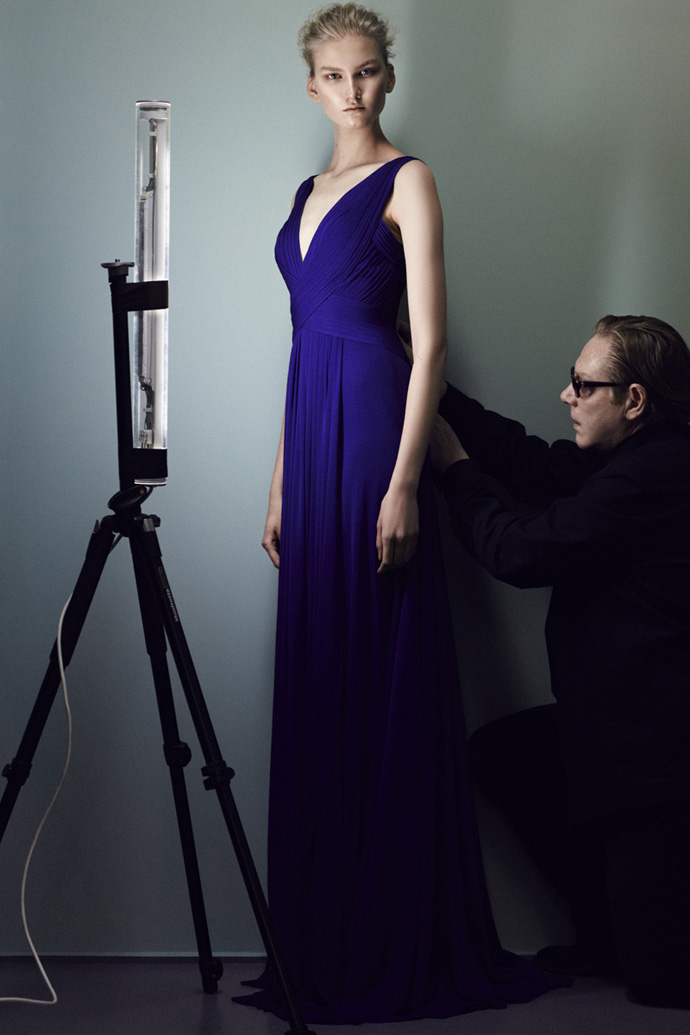
Mr.HL: When I was “Hervé Léger” I was never satisfied. Nothing was good enough and I always thought I could do better. Today, although I still want to do better I become emotional by looking at my own dresses, a feeling I never had before.
I am happier today because I don’t have anybody else involved in my business; I have a great team of loyal people working with me. Also what is very emotional for me is when I see women trying my clothes on.F.M: What is next for you?
Mr.HL: I’m working on developing my business. A perfume that I am working on. I want to start doing accessories, shoes, lingerie and swimsuits. Also my customers locked me in my atelier designing dresses – at least I am famous for something (laughs)- but you know I am very good in designing suits, coats, pants and blouses…Basically when you are wearing Herve L.Leroux, is for the evening. I want to make day-wear too. Although every time I do they never buy it, but I’m going to push.
The interview is a collaboration project between Un nouVeau iDEAL and The Stimuleye.
interview FILEP MOTWARY
photography RENE HABERMACHER
fashion editor SUZANNE VON AICHINGER
hair PANOS PAPANDRIANOS
make up YIANNIS SISKOS
model ANNA MARTYNOVA@ NEXT MODELSthank you VERSAE VANNI @ NEXT PARIS
-

Olivier Saillard, Violetta Sanchez, and 25 ways to be a turncoat
-“We nominate McQueen at Mugler and Armani Casa at Margiela…
We nominate Margiela at Schiaparelli and order him not to make any collections to preserve the surrealist spirit of the house.”

Curator Olivier Saillard hosted another one of his legend-in-the-making performances during couture week, this time in the intimate setting of the APC headquarters.
For 30 minutes, Saillard and his collaborator Violetta Sanchez pushed the classic man’s grey blazer to the limit (and beyond) by showing 25 ways it could be worn, while reciting a surreal list of nominations that read like a “who’s who” and a “what’s-wrong” with today’s fashion scene.
Can’t wait to see what Saillard comes up with next.
-

the museum of everything
-Art. What is it ? Where does it start, and where does it end ?
In today’s contemporary art “market”, it seems no one bothers asking the question anymore.
Art, as it would appear, is whatever is made by a self-claimed artist, whatever is recognized by the market.Enter The Museum of Everything.
Premiering in Paris at the new Saint-Germain location Chalet Society after several exhibits in London, this groundbreaking, sprawling, multi-level and multi-layered show changes the game.Forget the market.
For founder James Brett, it’s about special things, made by special people, people who haven’t gone to art school or thought of showing their work, much less of selling it.Antoine Asseraf: What started you on The Museum of Everything project ?
James Brett: I don’t come from a particularly artistic family and my parents never taught me what creativity meant – but as a child I had a lot of it and it always got in the way.And so I worked in different industries and was working in film, and I remember meeting a very interesting photographer, the late Bob Richardson. He was the father of Terry Richardson. Terry’s a terrible photographer (sorry!) but Bob was a genius. He was the first person who really told me that “You don’t choose it, it chooses you”.
In the same way, I can’t really tell you why I started The Museum of Everything. I didn’t set out to do it, I wasn’t interested in art, exhibitions, nothing. But I was working in film and I know film very well, I studied acting, so I’m creatively interested. And in my travels I started to see artworks, first of all by people in the American South, that was just cool and graphic. I always liked graphic novel and comics as a child – and as an adult frankly – and they started speaking to me.
The artworks were cheap, really like 20-25 bucks, and the more I looked the more I found. I started finding better examples, and realized there was a whole history in America of folk art, African-American art and self-taught art which seemed to come from the individual, it didn’t have the pretension or the words of formally-trained artists, and it was immediate. As a film-maker I loved that, because I’m not really interested in what you are or what you say, I’m interested in the stuff, in what you do.
As I continued I saw there were some other areas that had a great psychological depth. For example, the work of Henry Darger. I discovered there was a word for it, Art Brut, of which Dubuffet was the proponent. And that also interested me because in my youth, I was fascinated by the mind, how the mind works, and why we make the choices we do, all of this sort of existential philosophy of life.
Prophet Royal Robertson untitled (NO DIVORCE WHORE's ALLOWED), c 1980 © The Museum of Everything
-

the ANDAM
-230 000 euros for a young designers… who says the French don’t support talent ?
For 23 years now, the ANDAM prize, created by Nathalie Dufour and presided by no less than Pierre Bergé, has rewarded promising Paris-based fashion designers, regardless of nationality.
The first winner : Martin Margiela in 1989.
Since then, Viktor & Rolf, Christophe Lemaire, Felipe Oliveira Baptista, Gareth Pugh and last year Anthony Vaccarello have received the prize which includes not only a huge amount of money, but industry connections whose worth money cannot measure…The Stimuleye presents : ANDAM 2012.
ANDAM
Association Nationale pour le Développement des Arts de la Mode
2012 FASHION AWARDS
05/07/12GRAND PRIZE: 230 000 EURO
Nominees: Cédric Charlier, Julien David, Thomas Tait, Calla Haynes, Vika Gazinskaya, Andrea Nicholas Taralis
Winner: Julien DavidFIRST COLLECTION PRIZE: 60 000 EURO
Nominees: Calla Haynes, Pièce d’Anarchive, Céline Méteil, Jacquemus
Winner: Pièce d’Anarchivemore info: http://www.andam.fr
-

comme des garçons white drama
-A few weeks before the Hyères madness, I had the incredible opportunity to once again spend a few days with Galliera curator Olivier Saillard as he put together not 1 but 2 special exhibitions in a brand new space dedicated to fashion in Paris : Les Docks / Cité de la Mode et du Design.
Alongside a special Cristobal Balenciaga Collector exhibition contrasting the 20th Century designer’s creations with unseen objects in his personal collection, Saillard was putting together a second exhibition more anchored in the present, and even in the future:
WHITE DRAMA, an exhibition of Comme Des Garçons’ current SS 2012 collection, with an eye-popping scenography by Rei Kawakubo herself…
a PREMICES FILMS production
Directed by: Antoine Asseraf
Assisted by: Thibault Della Gaspera
Sound by: Pierre Emmanuel MartinetCOMME DES GARÇONS WHITE DRAMA /
CRISTOBAL BALENCIAGA COLLECTORCité de la Mode & du Design / Les Docks
34 Quai d’Austerlitz, Paris,
Until October 7, 2012. -

marc turlan: STAR NOTORIOUS
-First, he covered them up with a resin mask, then he cut their eyes out, with a scalpel and after with a laser. This is not Dexter, this is artist Marc Turlan, who always finds new ways of torturing magazines.With his latest solo show EXO STAR he is taking an artistic leap, opening this saturday at Galerie Anne de Villepoix in Paris.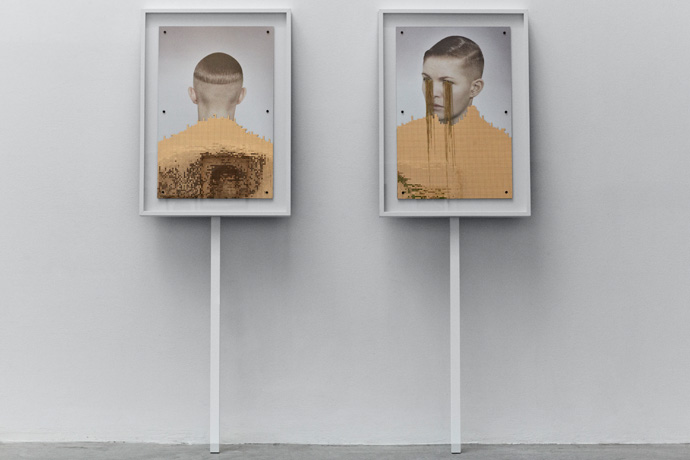 Marc Turlan: protest board 1 and 2, a collaboration with british photographer Timur Celikdag.
Courtesy gal Anne de VillepoixThe new sculptures of Marc Turlan conclude a logical extension of his appropriative work with the pages of glossy magazines:“The base of all i do is collage. The technique for my sculpture is the same way, it’s like 3 dimensional collages.”Right in the first room, the program for the exhibit gets clear: a gym workbench, weight bars in a stack, and 6 sheets of mirror, each with a word inscription of mirror mosaic, that serve as the commandments for this show: WORK – NOTORIETY – SINCERITY – POWER – LOVE
Marc Turlan: protest board 1 and 2, a collaboration with british photographer Timur Celikdag.
Courtesy gal Anne de VillepoixThe new sculptures of Marc Turlan conclude a logical extension of his appropriative work with the pages of glossy magazines:“The base of all i do is collage. The technique for my sculpture is the same way, it’s like 3 dimensional collages.”Right in the first room, the program for the exhibit gets clear: a gym workbench, weight bars in a stack, and 6 sheets of mirror, each with a word inscription of mirror mosaic, that serve as the commandments for this show: WORK – NOTORIETY – SINCERITY – POWER – LOVE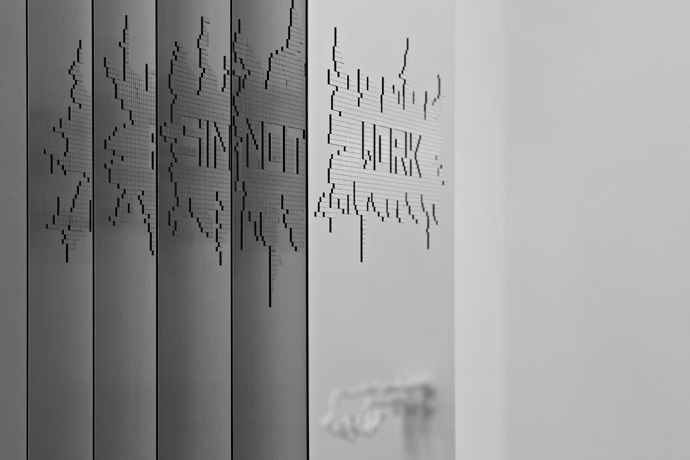 Marc Turlan: Statement Carpets. Courtesy gal Anne de Villepoix“It’s about the body. it’s erotic. Its a fetish to have in your mind to transform your body, to make a new image of yourself” he explains, next to two sculptures that look like snaffle headpieces with star shaped marble weights hanging from its leather thongs. It is inspired by gym gear to work your trapezius muscle. The materials surrounding us – leather, marble, mirror, wood. Marc Turlans recurrent structural elements are evident: eroticism, vanity, fetishism and notoriety.
Marc Turlan: Statement Carpets. Courtesy gal Anne de Villepoix“It’s about the body. it’s erotic. Its a fetish to have in your mind to transform your body, to make a new image of yourself” he explains, next to two sculptures that look like snaffle headpieces with star shaped marble weights hanging from its leather thongs. It is inspired by gym gear to work your trapezius muscle. The materials surrounding us – leather, marble, mirror, wood. Marc Turlans recurrent structural elements are evident: eroticism, vanity, fetishism and notoriety.Left: Marc Turlan's "Star Rack", and right: the artist himself
And there is of course, the star: “The star is the representation of the absolute, its a simple symbol for everyone. This desire, or fantasy to be recognised, to be famous, to arrive at this point… I use the star in marble.”In Marc Turlans “gym” you actually work out with the star as a marble weight, stemming the symbol of the desired recognition and thus transform yourself through and towards that idea.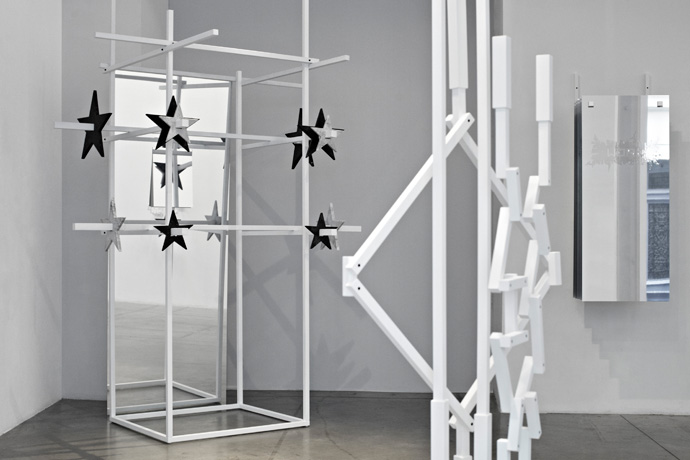 The first room of EXO STAR with "Home Star-Gym". Courtesy Gallery Anne de VillepoixThe second room is pitch black and only lit by pulsating light bulbs on a cluster of stars, an array of audio sculptures speak to the visitor with each a “collage sonore” (sound collage). Corresponding to the acoustic rework of a writers text hangs a framed object, containing a book of the same author with a mirror mosaic highlighting a sentence.“I keep a sentence very different to the audio collage. It is a proposition, an open invitation. I don’t work in an interactive way. I am interested in the object. It becomes a sculpture” he explains.
The first room of EXO STAR with "Home Star-Gym". Courtesy Gallery Anne de VillepoixThe second room is pitch black and only lit by pulsating light bulbs on a cluster of stars, an array of audio sculptures speak to the visitor with each a “collage sonore” (sound collage). Corresponding to the acoustic rework of a writers text hangs a framed object, containing a book of the same author with a mirror mosaic highlighting a sentence.“I keep a sentence very different to the audio collage. It is a proposition, an open invitation. I don’t work in an interactive way. I am interested in the object. It becomes a sculpture” he explains.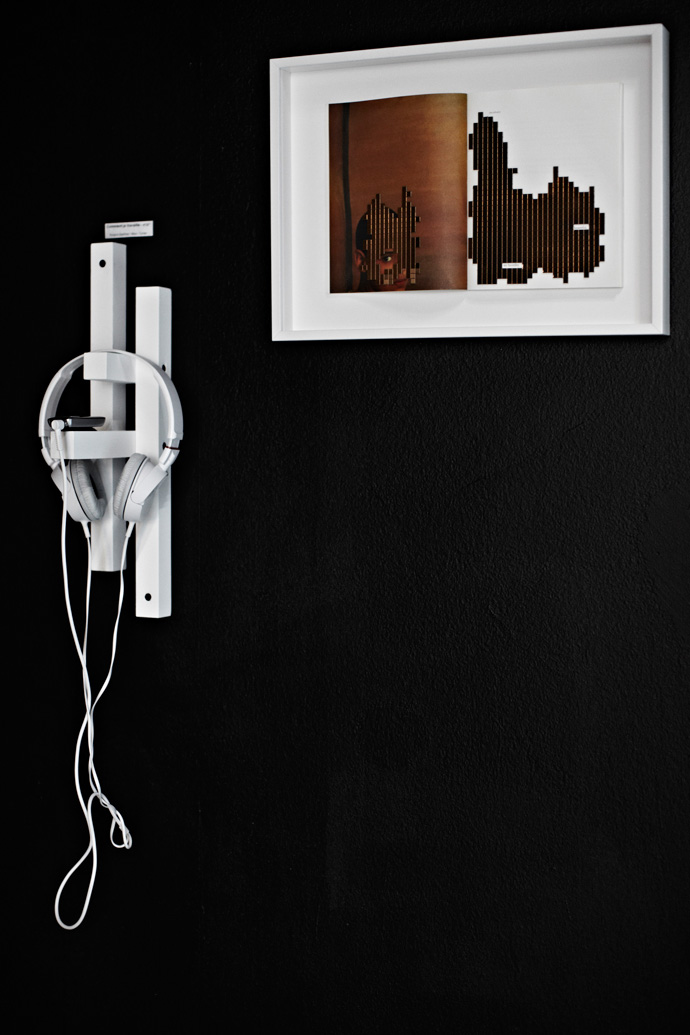
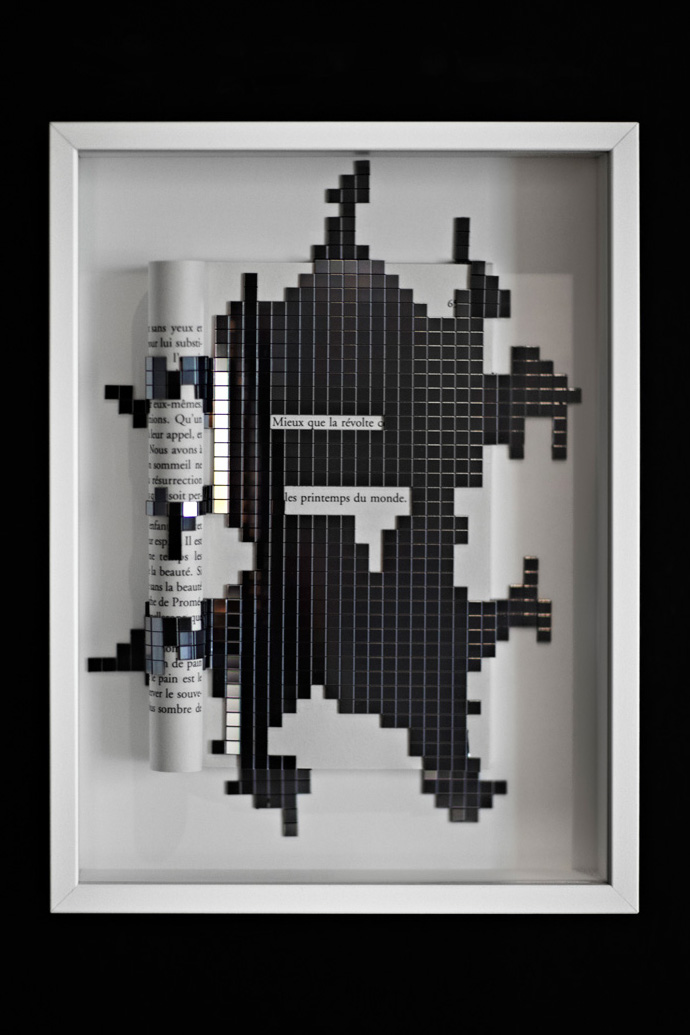 The collage sonore / sound collage installation in room 2. Courtesy Gallery Anne de VillepoixNear the pass to the next room the only book that depicts an image and with this marks the transition to the last complex of works. It’s all about stars and fashion magazines. But now the presentation enhances the fact that the magazines departed from being just the source of material. They become objects themselves, so does the frame and the fixture. It becomes altogether an installation: A cabinet of seven blocks present the works on shelves, hung, or in frames that at times can be turned and reveal a mirror. Mirrors everywhere. “Beyond, beyond, beyond the mirror”, as Patti Smith proclaims earlier in one of the audio collages.
The collage sonore / sound collage installation in room 2. Courtesy Gallery Anne de VillepoixNear the pass to the next room the only book that depicts an image and with this marks the transition to the last complex of works. It’s all about stars and fashion magazines. But now the presentation enhances the fact that the magazines departed from being just the source of material. They become objects themselves, so does the frame and the fixture. It becomes altogether an installation: A cabinet of seven blocks present the works on shelves, hung, or in frames that at times can be turned and reveal a mirror. Mirrors everywhere. “Beyond, beyond, beyond the mirror”, as Patti Smith proclaims earlier in one of the audio collages.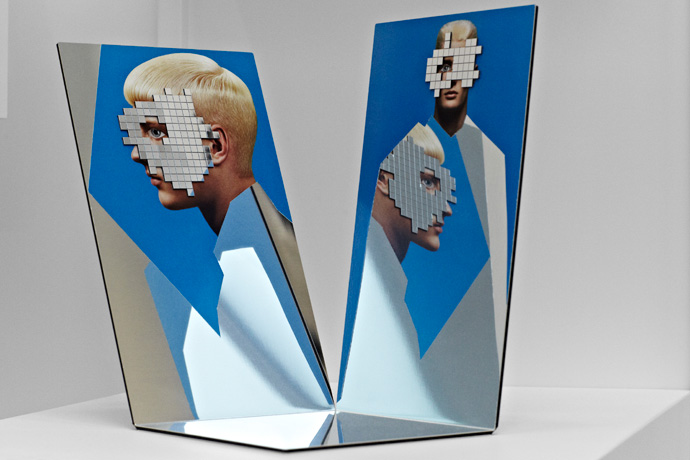 Object in room 3 at Gallery Anne de VillepoixMarc Turlan: EXO STARopening Saturday 10th, running to October 15th 2011at Galerie Anne de Villepoix, rue de Montmorency, 75003 Paris
Object in room 3 at Gallery Anne de VillepoixMarc Turlan: EXO STARopening Saturday 10th, running to October 15th 2011at Galerie Anne de Villepoix, rue de Montmorency, 75003 Paris -

What will you do for the summer holidays?
-What will you do for the summer holidays? This is a question we here often these days, a perfect conversation piece celebrated from Athens to Paris, London to New York. As a result of this planning many cities will be left deserted at the peak of August. So where do we go?
Travelling, the outlook to discover new and exotic places are something that stimulates us and we look forwards to.
How we could have left that out at The Stimuleye? I don’t know, it’s almost a crime!So we decided to start another series of special places that inspire and enlighten in one or another way. Off track, from a beach bar on a secluded island in Kenya to a spooky ryokan in Japan. And we’ll include food in addition that seems an important part of this experience. Specially considering that Stimuleye Antoine Asseraf had ran a blog around food: FOODGEEK, one of the godparents to The Stimuleye. That might all sound very TAMPOPO – and yes that’s exactly where we’re going with this.
So learn about the addresses for the best Japanese rahmen noodles or Mexican bull-meat tacos, Greek homemade pies, hefty Cuban mojitos or the perfect ring formed bread that’s handed out hung on thread to hold it best, since it’s hot and oven-fresh!
You might stay home during the summer, but nevertheless and hopefully, one of the places we’ll cover in this series starting from tomorrow, will be near you to discover. If you have a tip you believe should be shared and not left out, let us know!
Scene from alltime ultimate Japanese foodgeek movie TAMPOPO. Directed by Jûzô Itami, 1985
-

Not all fun and games : Abdel Bounane
-Last month, the Gaïté Lyrique digital creation center opened its doors in Paris, after many years of construction.
A companion shop also opened next to the gorgeous building : the AMUSEMENT creative shop.
We sat down with Abdel Bounane, who is in charge of the store but also the founder and editor-in-chief of AMUSEMENT magazine.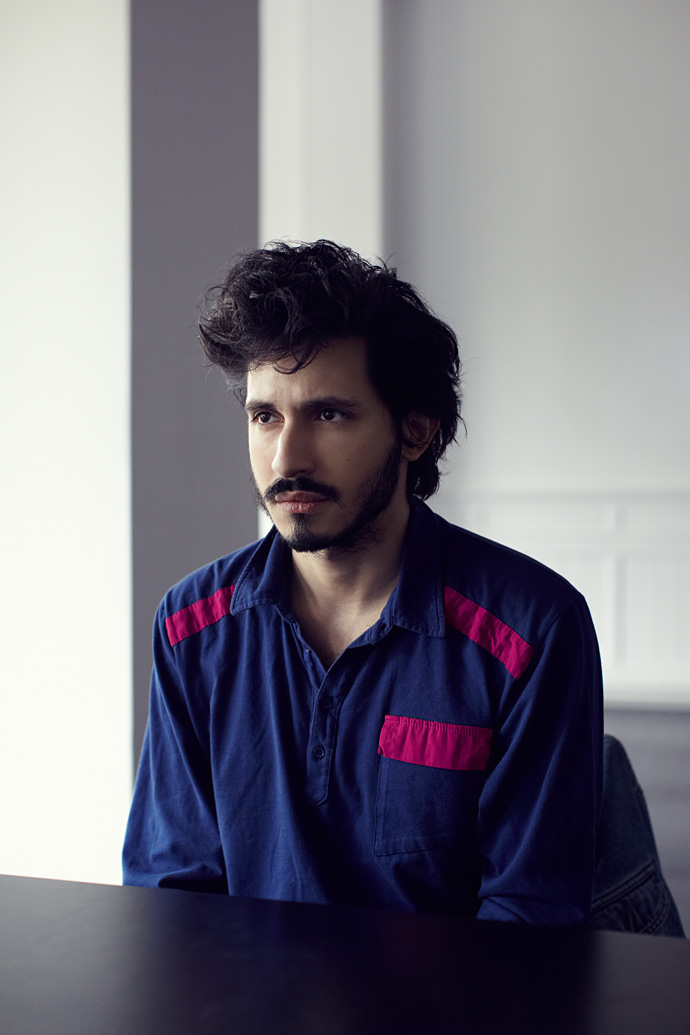 Abdel Bounane at AMUSEMENT gallery, by René Habermacher.
Abdel Bounane at AMUSEMENT gallery, by René Habermacher.Antoine Asseraf : So where are we, there’s a store downstairs, but this is something else…
Abdel Bounane: This is the space where soon we will offer services and events linked to the store, and to the magazine.
The service part is probably the most interesting, because this is going to be the most original part.
For the store we try to have some original products, but for services, starting in May, you’ll be able to order a tailor-made video game.You make an appointment, meet with one of our consultants, and give your craziest ideas regarding what you want from a video game, and we’ll be able to materialize it. It can take a few days, a few weeks, or sometimes a few months, it can cost a few hundred or a few thousand euros.
It’s a world first.
It answers the question “if you want to make a space linked to the digital world, how do you offer something original and human ?”Something that doesn’t lag behind the virtual world.
Exactly. What is the use of being in the real world when you’re talking about the virtual ?
So for me, it is the meeting with people, the ability to explain face to face your ideas, a human and interactive touch, it’s fundamentally linked to a physical place. It wouldn’t be the same thing by Skype.That’s one part of the services we will offer.
We will also offer a gallery side.
People have been trying to sell digital art for decades now, and they haven’t really been able to, except for installations which hard to sustain. But now tablets are here, and I feel that tablets are a good media for that art, like a canvas.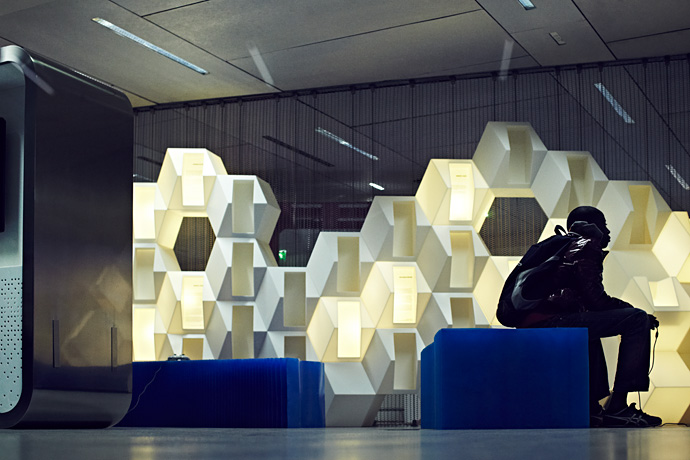 The ressource center of the Gaïté Lyrique. By René Habermacher.
The ressource center of the Gaïté Lyrique. By René Habermacher.That makes me think of that bloom application for iPhone, by Brian Eno…
Well, Brian Eno’s been here !
What we’re developing is the sell of pieces on tablets, offline, and also an online store of limited edition digital content, with a certificate of authenticity on our servers.How do you co-exist with the Gaïté Lyrique proper?
Well with the digital art we’re going to be working a lot with artists from the Gaïté, such as Matt Pyke/Universal Everything,
They do a lot of cool particle effects, very pop, very colorful, and they’re don’t want something that is all over the internet, just something that is visible physically at the Gaïté, because it’s a site-specific installation, and potentially sold digitally.That’s where the logic of the Gaïté comes in, it’s not a museum, it’s a creation center.
So it’s perfect for us, we become the distributors of content that cannot be found elsewhere, and digital limited edition fits the Gaïté perfectly.We’re not only the commercial arm of the Gaïté, we’re here to play with new ways of crossing art and digital, video games and one-to-one distribution, or take a mass media like video games and make it personalized, how do me make something pop more haute ?
How to legitimize a physical location, with launches, workshops, etc.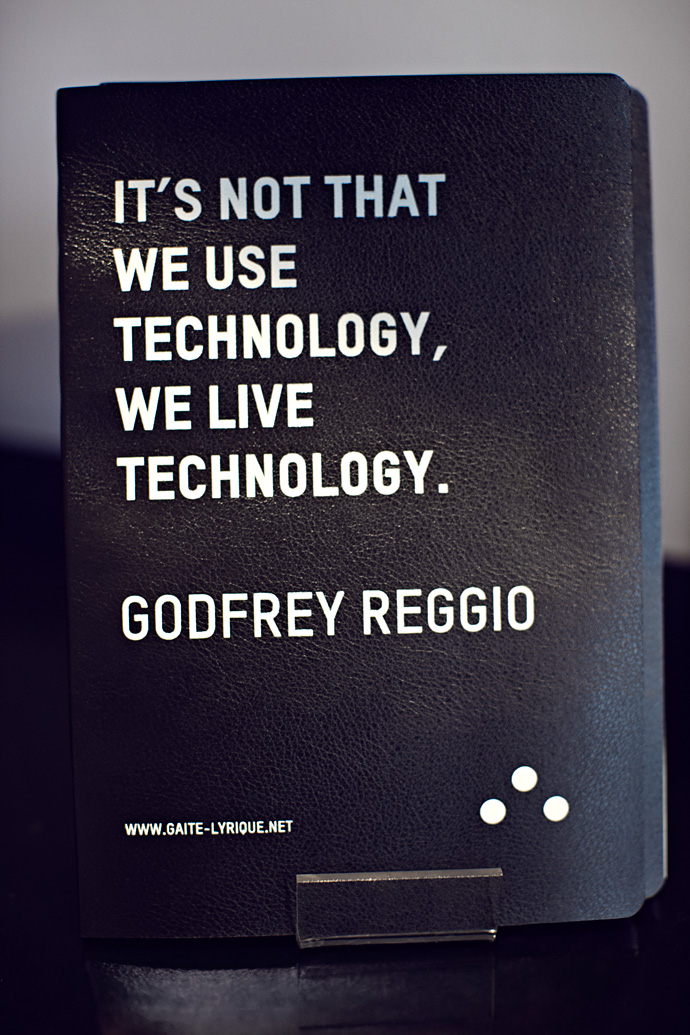 Gaïté Lyrique communication.
Gaïté Lyrique communication. -

NJA MAHDAOUI: strokes of liberation
-Nja Mahdaoui is one of the most celebrated living contemporary artists in the arab world. His bold and highly rhythmic work, derived from the arabic letter, is internationally renowned and can be found in ther permanent collections of the Institut du Monde Arabe, The British Museum and The Smithsonian Institution just to name a few.
It’s an exuberance of arabesque forms, a visual melody played out of his hand, that remind us of the great gestural and physical richness of action painting. Famous for his meticulous inks on parchment, this “liberated calligraphy” is worked across a variety of extremely different surfaces — from canvas, brass, wood, melamine and papyrus to skin. Though It seems like writing, it is not. It is rather an interlacing of a dialectic relationship, also found within Western abstraction.
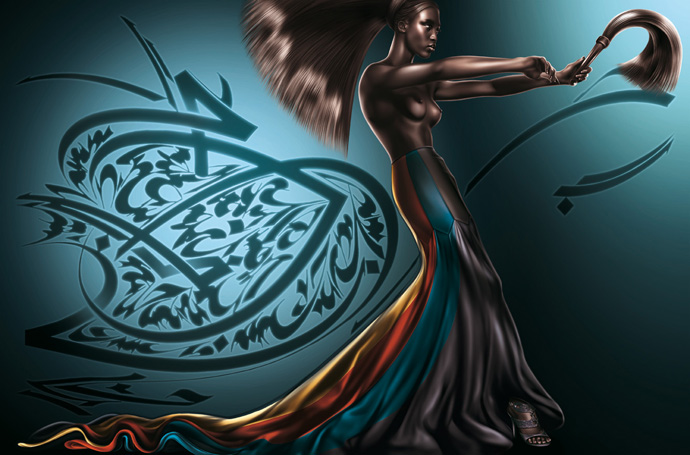 Naomi Campbell in Azzedine Alaïa for Numéro Magazine. A collaboration between Nja Mahdaoui and René Habermacher
Naomi Campbell in Azzedine Alaïa for Numéro Magazine. A collaboration between Nja Mahdaoui and René HabermacherI came across the work of Nja Mahdaoui the first time, while researching calligraphic styles on a project for the French magazine Numéro on a piece about Azzedine Alaïa to which Babeth Djian incited me. The visual impact of Nja’s work struck me at first sight.
Slightly intimidated by the references of the rich body of his work, I first hesitated but then thought to give it a shot, and contacted him. To my surprise he answered me instantly by email, and called me shortly after. Our collaboration was set — and we created a story of imaginary movements around Naomi Campbell as a dark gazelle, in sheer and revealing Alaïa.
But I only met Nja Mahdaoui in person two summers ago in Tunis. It was an all-embracing, hot and sultry August day that lay heavy on the city, matching the emotional state of its people.
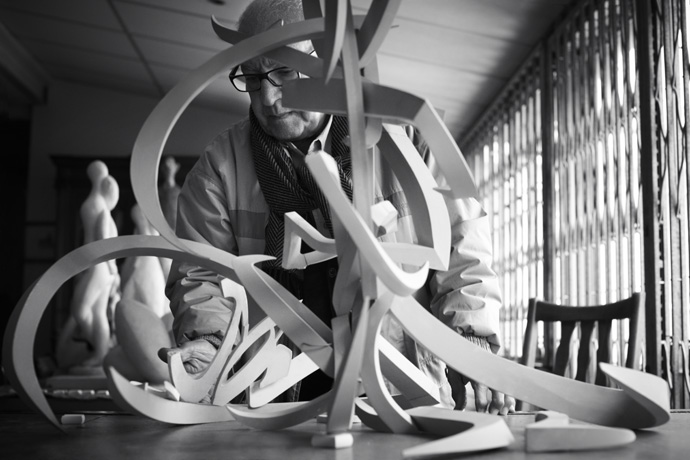 Nja Mahdaoui wit the first prototype of his most recent sculpture. Photography by René Habermacher
Nja Mahdaoui wit the first prototype of his most recent sculpture. Photography by René HabermacherA couple of months after the “Jasmine revolution” took place, Nja arrives in full swing to our meeting at a café in sunny, springtime Paris.
He’d come with his daughter Molka Mahdaoui to work on another of his new projects, yet is consumed with excitement by the events. He reacts immediately and impulsively to the question I usually ask last on conversations for The Stimuleye: What is the last thing that stimulated you?
“Stimulated? You’re asking a Tunisian? (laughs). I don’t know if ‘stimulated’ is the word, but it’s the explosion of a generation, I’m completely into it — for us it’s the event of the century!”
 Nja Mahdaoui: "Graphemes on Arches 2", 2009, Ink on arches paper; 135cm x 135cm.
Nja Mahdaoui: "Graphemes on Arches 2", 2009, Ink on arches paper; 135cm x 135cm.With us at the table are the collaborators involved in the process of making his latest project, a sculpture, the main reason for his trip north. Nja loves collaborations – his eyes glow while he talks energetically about upcoming projects. An energy I felt the first time I saw his bold and highly rhythmic work: “a dance of calligraphy”, with Nja as the choreographer of imaginary letters, to which he refers as ‘graphemes’, devoid of actual textual meaning:
“To a non-Arabic speaker it appears as coherent text. In fact even Arabic speakers assume at first that it’s a text with meaning. But when they start reading it they realise it is not an actual word.” he says and recalls an experience:
“It is not easy to write letters in a disjointed way — that is disjointed to not mean anything — and focus only on the aesthetic. There was a study at the California Institute of Technology in Pasadena. They connected me to a machine in order to test the levels of stress my body was under when I was writing proper words and when I was writing words without meaning. The study showed that my body was 2.5 times more stressed when I was working on words without meaning. So it is a very conscious attempt to create art. I tell people I’m not a calligrapher, but an artist.”
To me his body of work is so vibrant and remarkably innovative that I first had assumed Nja to be in his early 30’s the most, yet he was born in La Marsa, Tunisia, in 1937. As Molka, a filmmaker herself, puts it during our conversation: “sometimes i have to remind myself: Molka, you are thinking older than your own father!”.
 Nja Mahdaoui: Design for Gulf Air 50th Anniversary. Image Courtesy of Nja Mahdaoui
Nja Mahdaoui: Design for Gulf Air 50th Anniversary. Image Courtesy of Nja Mahdaoui
